#2) had a version released in the up to the early 90s (so it's conceivable he had that in his collection)
Explore tagged Tumblr posts
Photo
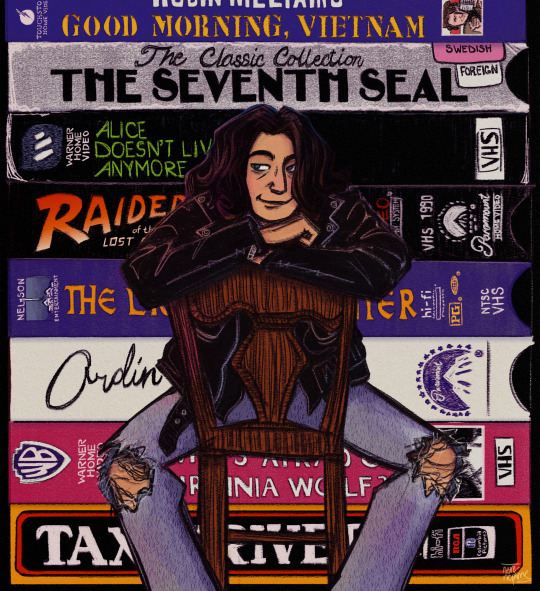
“Good movies are always better when you watch them with someone.” - Ed Chigliak (Northern Exposure)
#if there's anything to know about ed it's that his love of films and filmmaking is a MAJOR defining aspect of his personality#you may claim to love movies but i doubt you love movies as much as ed does#and i've said it once and i'll say it again: he would kill it on letterboxd#the movies mentioned in the pic in order are:#good morning vietnam#the seventh seal#alice doesn't live here anymore#indiana jones: raiders of the lost ark#the lion of winter#ordinary people#who's afraid of virginia woolf?#taxi driver#ed chigliak#my art#and yes. yes i did draw all those vhs tape spines#i specifically looked for movies that were 1) mentioned in the show by ed or implied that ed owns#2) had a version released in the up to the early 90s (so it's conceivable he had that in his collection)#and 3) had text or images that would be visible behind his body and chair#artists on tumblr#northern exposure
120 notes
·
View notes
Text
The Story Behind Every Song on folklore - According to Aaron Dessner
By: Brady Gerber for Vulture Date: July 27th 2020

The National multi-instrumentalist spoke to Vulture over the phone from upstate New York a few hours after the surprise release of Swift’s eighth studio album. (“A pretty wild ride,” he admits, sounding tired yet happy.) He was clear that he can’t speak on behalf of Swift’s lyrics, much like he can’t for The National frontman Matt Berninger’s either, or the thinking behind Jack Antonoff’s songs. (Here’s a cheat sheet: Jack’s songs soar, Aaron’s glide.) But Dessner was game to speak to his specific contributions, influences, and own interpretations of each song on folklore, a record you can sum up by two words that came up often during our conversation: nostalgic and wry.
“the 1″
“the 1” and “hoax,” the first song and the last song, were the last songs we did. The album was sort of finished before that. We thought it was complete, but Taylor then went back into the folder of ideas that I had shared. I think in a way, she didn’t realize she was writing for this album or a future something. She wrote “the 1,” and then she wrote “hoax” a couple of hours later and sent them in the middle of the night. When I woke up in the morning, I wrote her before she woke up in LA and said, “These have to be on the record.” She woke up and said, “I agree” [laughs] These are the bookends, you know?
It’s clear that “the 1” is not written from her perspective. It’s written from another friend’s perspective. There’s an emotional wryness and rawness, while also to this kind of wink in her eyes. There’s a little bit of her sense of humor in there, in addition to this kind of sadness that exists both underneath and on the surface. I enjoy that about her writing.
The song began from the voice memo she sent me, and then I worked on the music some and we tracked her vocals, and then my brother added orchestration. There are a few other little bits, but basically that was one of the very last things we did.
“cardigan“
That’s the first song we wrote [in early May]. After Taylor asked if I would be interested in writing with her remotely and working on songs, I said, “Are you interested in a certain kind of sound?” She said, “I’m just interested in what you do and what you’re up to. Just send anything, literally anything, it could be the weirdest thing you’ve ever done,” so I sent a folder of stuff I had done that I was really excited about recently. “cardigan” was one of those sketches; it was originally called “Maple.” It was basically exactly what it is on the record, except we added orchestration later that my brother wrote.
I sent [the file] at 9 p.m., and around 2 a.m. or something, there was “cardigan,” fully written. That’s when I realized something crazy was happening. She just dialed directly into the heart of the music and wrote an incredible song and fully conceived of it and then kept going. It harkens back to lessons learned, or experiences in your youth, in a really beautiful way and this sense of longing and sadness, but ultimately, it’s cathartic. I thought it was a perfect match for the music, and how her voice feels. It was kind of a guide. It had these lower register parts, and I think we both realized that this was a bit of a lightning rod for a lot of the rest of the record.
The National’s Influence On Swift
She said that she’s a fan of the emotion that’s conveyed in our music. She doesn’t often get to work with music that is so raw and emotional, or melodic and emotional, at the same time. When I sent her the folder, that was one of the main feelings. She said, “What the fuck? How do you just have that?” [laughs] I was humbled and honored because she just said, “It’s a gift, and I want to write to all of this.” She didn’t write to all of it, but a lot of it, and relatively quickly.
She is a fan of the band, and she’s a fan of Big Red Machine. She’s well aware of the sentiment of it and what I do, but she didn’t ask for a certain kind of thing. I know that the film [I Am Easy To Find] has really affected her, and she’s very much in love with that film and the record. Maybe it’s subconsciously been an influence.
“the last great american dynasty”
I wrote that after we’d been working for a while. It was an attempt to write something attractive, more uptempo and kind of pushing. I also was interested in this almost In Rainbows-style latticework of electric guitars. They come in and sort of pull you along, kind of reminiscent of Big Red Machine. It was very much in this sound world that I’ve been playing around with, and she immediately clicked with that. Initially I was imagining these dreamlike distant electric guitars and electronics but with an element of folk. There’s a lot going on in that sense. I sent it before I went on a run, and when I got back from the run, that song was there [laughs].
She told me the story behind it, which sort of recounts the narrative of Rebekah Harkness, whom people actually called Betty. She was married to the heir of Standard Oil fortune, married into the Harkness family, and they bought this house in Rhode Island up on a cliff. It’s kind of the story of this woman and the outrageous parties she threw. She was infamous for not fitting in, entirely, in society; that story, at the end, becomes personal. Eventually, Taylor bought that house. I think that is symptomatic of folklore, this type of narrative song. We didn’t do very much to that either.
“exile” (ft. Bon Iver)
Taylor and William Bowery, the singer-songwriter, wrote that song initially together and sent it to me as a sort of a rough demo where Taylor was singing both the male and female parts. It’s supposed to be a dialogue between two lovers. I interpreted that and built the song, played the piano, and built around that template. We recorded Taylor’s vocals with her singing her parts but also the male parts.
We talked a lot about who she thought would be perfect to sing, and we kept coming back to Justin [Vernon]. Obviously, he’s a dear friend of mine and collaborator. I said, “Well, if he’s inspired by the song, he’ll do it, and if not, he won’t.” I sent it to him and said, “No pressure at all, literally no pressure, but how do you feel about this?” He said, “Wow.” He wrote some parts into it also, and we went back and forth a little bit, but it felt like an incredibly natural and safe collaboration between friends. It didn’t feel like getting a guest star or whatever. It was just like, well, we’re working on something, and obviously he’s crazy talented, but it just felt right. I think they both put so much raw emotion into it. It’s like a surface bubbling. It’s believable, you know? You believe that they’re having this intense dialogue.
With other people I had to be secretive, but with Justin, because he was going to sing, I actually did send him a version of the song with her vocals and told him what I was up to. He was like, “Whoa! Awesome!” But he’s been involved in so many big collaborative things that he wasn’t interested in it from that point of view. It’s more because he loved the song and he thought he could do something with it that would add something.
“my tears ricochet”
This is one of my absolute favorite songs on the record. I think it’s a brilliant composition, and Taylor’s words, the way her voice sounds and how this song feels, are, to me, one of the critical pieces. It’s lodged in my brain. That’s also very important to Taylor and Jack. It’s like a beacon for this record.
“mirrorball”
“mirrorball” is, to me, a hazy sort of beautiful. It almost reminds me of ‘90s-era Cardigans, or something like Mazzy Star. It has this kind of glow and haze. It feels really good before “seven,” which becomes very wistful and nostalgic. There are just such iconic images in the lyrics [“Spinning in my highest heels”], which aren’t coming to me at the moment because my brain is not working [laughs].
How Jack Antonoff’s Folklore Songs Differ From Dessner’s
I think we have different styles, and we weren’t making them together or in the same room. We both could probably come closer together in a sense that weirdly works. It’s like an archipelago, and each song is an island, but it’s all related. Taylor obviously binds it all together. And I think Jack, if he was working with orchestrations, there’s an emotional quality to his songs that’s clearly in the same world as mine.
We actually didn’t have a moodboard for the album at all. I don’t think that way. I don’t really know if she does either. I don’t think Jack... well, Jack might, but when I say the Cardigans or Mazzy Star, those aren’t Jack’s words about “mirrorball,” it’s just what calls to mind for me. Mainly she talked about emotion and to lean into it, the nostalgia and wistfulness, and the kind of raw, meditative emotion that I often kind of inhabit that I think felt very much where her heart was. We didn’t shy away from that.
“seven”
This is the second song we wrote. It’s kind of looking back at childhood and those childhood feelings, recounting memories and memorializing them. It’s this beautiful folk song. It has one of the most important lines on the record: “And just like a folk song, our love will be passed on.” That’s what this album is doing. It’s passing down. It’s memorializing love, childhood, and memories. It’s a folkloric way of processing.
“august”
This is maybe the closest thing to a pop song. It gets loud. It has this shimmering summer haze to it. It’s kind of like coming out of “seven” where you have this image of her in the swing and she’s seven years old, and then in “august” I think it feels like fast-forwarding to now. That’s an interesting contrast. I think it’s just a breezy, sort of intoxicating feeling.
“this is me trying”
“this is me trying,” to me, relates to the entire album. Maybe I’m reading into it too much from my own perspective, but [I think of] the whole album as an exercise and working through these stories, whether personal or old through someone else’s perspective. It’s connecting a lot of things. But I love the feeling in it and the production that Jack did. It has this lazy swagger.
“illicit affairs”
This feels like one of the real folk songs on the record, a sharp-witted narrative folk song. It just shows her versatility and her power as a songwriter, the sharpness of her writing. It’s a great song.
“invisible string”
That was another one where it was music that I’d been playing for a couple of months and sort of humming along to her. It felt like one of the songs that pulls you along. Just playing it on one guitar, it has this emotional locomotion in it, a meditative finger-picking pattern that I really gravitate to. It’s played on this rubber bridge that my friend put on [the guitar] and it deadens the strings so that it sounds old. The core of it sounds like a folk song.
It’s also kind of a sneaky pop song, because of the beat that comes in. She knew that there was something coming because she said, “You know, I love this and I’m hearing something already.” And then she said, “This will change the story,” this beautiful and direct kind of recounting of a relationship in its origin.
“mad woman”
That might be the most scathing song on folklore. It has a darkness that I think is cathartic, sort of witch-hunting and gaslighting and maybe bullying. Sometimes you become the person people try to pin you into a corner to be, which is not really fair. But again, don’t quote me on that [laughs], I just have my own interpretation. It’s one of the biggest releases on the album to me. It has this very sharp tone to it, but sort of in gothic folklore. It’s this record’s goth song.
“epiphany”
For “epiphany,” she did have this idea of a beautiful drone, or a very cinematic sort of widescreen song, where it’s not a lot of accents but more like a sea to bathe in. A stillness, in a sense. I first made this crazy drone which starts the song, and it’s there the whole time. It’s lots of different instruments played and then slowed down and reversed. It created this giant stack of harmony, which is so giant that it was kind of hard to manage, sonically, but it was very beautiful to get lost in. And then I played the piano to it, and it almost felt classical or something, those suspended chords.
I think she just heard it, and instantly, this song came to her, which is really an important one. It’s partially the story of her grandfather, who was a soldier, and partially then a story about a nurse in modern times. I don’t know if this is how she did it, but to me, it’s like a nurse, doctor, or medical professional, where med school doesn’t fully prepare you for seeing someone pass away or just the difficult emotional things that you’ll encounter in your job. In the past, heroes were just soldiers. Now they’re also medical professionals. To me, that’s the underlying mission of the song. There are some things that you see that are hard to talk about. You can’t talk about it. You just bear witness to them. But there’s something else incredibly soothing and comforting about this song. To me, it’s this Icelandic kind of feel, almost classical. My brother did really beautiful orchestration of it.
“betty”
This one Taylor and William wrote, and then both Jack and I worked on it. We all kind of passed it around. This is the one where Taylor wanted a reference. She wanted it to have an early Bob Dylan, sort of a Freewheelin’ Bob Dylan feel. We pushed it a little more towards John Wesley Harding, since it has some drums. It’s this epic narrative folk song where it tells us a long story and connects back to “cardigan.” It starts to connect dots and I think it’s a beautifully written folk song.
Is ‘betty” queer canon? I can’t speak to what it’s about. I have my own ideas. I also know where Taylor’s heart is, and I think that’s great anytime a song takes on greater meaning for anyone.
Is William Bowery secretly Joe Alwyn? I don’t know. We’re close, but she won’t tell me that. I think it’s actually someone else, but it’s good to have some mysteries.
“peace”
I wrote this, and Justin provided the pulse. We trade ideas all the time and he made a folder, and there was a pulse in there that I wrote these basslines to. In the other parts of the composition, I did it to Justin’s pulse. Taylor heard this sketch and she wrote the song. It reminds me of Joni Mitchell, in a way - there’s this really powerful and emotional love song, even the impressionistic, almost jazz-like bridge, and she weaves it perfectly together. This is one of my favorites, for sure. But the truth is that the music, that way of playing with harmonized basslines, is something that probably comes a little bit from me being inspired by how Justin does that sometimes. There’s probably a connection there. We didn’t talk too much about it [laughs].
“hoax”
This is a big departure. I think she said to me, “Don’t try to give it any other space other than what feels natural to you.” If you leave me in a room with a piano, I might play something like this. I take a lot of comfort in this. I think I imagined her playing this and singing it. After writing all these songs, this one felt the most emotional and, in a way, the rawest. It is one of my favorites. There’s sadness, but it’s a kind of hopeful sadness. It’s a recognition that you take on the burden of your partners, your loved ones, and their ups and downs. That’s both “peace” and “hoax” to me. That’s part of how I feel about those songs because I think that’s life. There’s a reality, the gravity or an understanding of the human condition.
Does Taylor Explain Her Lyrics?
She would always talk about it. The narrative is essential, and kind of what it’s all about. We’d always talk about that upfront and saying that would guide me with the music. But again, she is operating at many levels where there are connections between all of these songs, or many of them are interrelated in the characters that reappear. There are threads. I think that sometimes she would point it out entirely, but I would start to see these patterns. It’s cool when you see someone’s mind working.
“the lakes”
That’s a Jack song. It’s a beautiful kind of garden, or like you’re lost in a beautiful garden. There’s a kind of Greek poetry to it. Tragic poetry, I guess.
The Meaning Of Folklore
We didn’t talk about it at first. It was only after writing six or seven songs, basically when I thought my writing was done, when we got on the phone and said, “OK, I think we’re making an album. I have these six other ideas that I love with Jack [Antonoff] that we’ve already done, and I think what we’ve done fits really well with them.” It’s sort of these narratives, these folkloric songs, with characters that interweave and are written from different perspectives. She had a vision, and it was connecting back in some way to the folk tradition, but obviously not entirely sonically. It’s more about the narrative aspect of it.
I think it’s this sort of nostalgia and wistfulness that is in a lot of the songs. A lot of them have this kind of longing for looking back on things that have happened in your life, in your friend’s life, or another loved one’s life, and the kind of storytelling around that. That was clear to her. But then we kept going, and more and more songs happened.
It was a very organic process where [meaning] wasn’t something that we really discussed. It just kind of would happen where she would dive back into the folder and find other things that were inspiring. Or she and William Bowery would write “exile,” and then that happened. There were different stages of the process.
Okay, but is it A24-core? [Laughs.] Good comparison.
#Aaron Dessner#interview#vulture#about taylor#taylor swift#folklore album#folklore era#songwriting#producer#the national#bon iver
730 notes
·
View notes
Note
How about those JL storyboards?
In case you haven’t heard, Zack Snyder is putting on display the ‘storyboards’ - i.e. a rough plot summary accompanied by some Jim Lee sketches - for what would have been Justice League 2 and 3, or as this puts it 2 and ‘2A’. You can see them here (I imagine better-quality versions will soon be released), and read a transcript here. This is evidently a very early version: this was apparently pitched prior to the release of BvS and Justice League being rewritten in the wake of it, with numerous plot details that now don’t line up with what we know about the Snyder Cut, plus it outright mentions it builds on the originally planned versions of the Batman and Flash movies. But it’s a broad outline of what was gonna go down, and while I initially thought it was Snyder throwing in the towel, the timing - paired with the ambiguity left by the necessity for changes, including that this doesn’t factor whatever that “massive cliffhanger” at the end of the Cut is - says to me he’s hoping this’ll be a force multiplier behind efforts to will sequel/s into existence. He’s probably right.
I’ll be discussing spoilers below, but in short: with this Zack Snyder has finally lived up to Alan Moore, in that like Twilight of the Superheroes I wouldn’t believe this was real as opposed to a shockingly on-point parody if not for direct, irrefutable evidence.
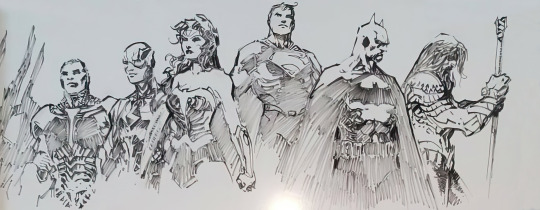
Doing some rapid-fire bullet points for this baby to kick us off:
* Folks who know the subject say a lot of this is a yet further continuation of Snyder doing Arthuriana fanfic with the League reskinned over those major players, and I’ll take their word for it.
* I don’t know whether I love or hate that in Justice League 2 the Justice League are only an extant thing for the first scene, and then it’s Snyder giving everybody their own mini-movies. It’s compressing the entire MCU “loosely interconnected solo stories leading to a single big movie later” strategy into a single movie!
* Funniest line in the whole thing: "Even Lantern has heard of the Kryptonian, worried that he's under the control of Darkseid. He heard his spirit was unbreakable." Hal what fuckin' Superman movie did YOU watch? Second funniest being “IT WILL GIVE HIM POWER OVER ALL LIVING LIFE”
* 90% of the plot I have nothing to say about, it’s generic stage-setting crap. That to be clear is the ‘shocked it’s Snyder’ element, it feels so crassly commercial in a way I can’t believe is coming from the BvS guy.
* Most of what I have to say is unsurprisingly gonna be about a handful of characters but Cyborg’s happy ending being “he isn’t visibly disabled anymore!” is not great!
* The Goddess of War battle with Superman...never pays off? No clue why it’s there.
* What I’d originally heard was that the Codex in Superman’s blood was the last key to the Anti-Life Equation and that’s why Darkseid was coming to Earth. It’s not like all of this wouldn’t have already been averted by Kal-El’s pod smacking into an asteroid on the way to Earth so it’s not as if this makes it any more Superman’s fault, and it would have at least tied all this back to the beginning of the movies, but I suppose that was either fake or from a later draft.
* I have NO idea how this was reimagined without the ‘love triangle’, it’s the central character thing and the entire climax flows directly out of it!
* Darkseid’s kinda a chump in this, huh

Anonymous said: So: Does Zack Snyder hate Superman?
Look: the hilarity of this when Cuck Kent has been a go-to Snyder cult insult towards ‘inferior’ takes on Superman for years cannot be understated, yet at the same time I can almost wrap my brain around where Snyder’s coming from with that as the end for his take on the character. He talked in that Variety piece on how his interest in Superman is informed by having adopted children himself, and Deborah Snyder is the stepmother to his kids by previous relationships, so I can see where he’d be coming from, and I can even imagine how he’d see this as ‘rhyming’ in the sense of “the series begins with Kal-El being adopted by Earth, it ends with him adopting a child of Earth!” In the same way as MARTHA, I can envision how he would put these pieces together in his head thematically without registering or caring what the end result would actually look like. In this case, Superman raising the kid of the man who beat the shit out of him who Batman had with Clark’s wife, who earlier told Bruce she was staying with Clark because he ‘needed her’, suggesting if inadvertently that this really honest to god was a “she’s only staying with Superman out of pity, she really loved Batman more” thing.
But Clark is nothing in this. He’s sad and existential because of coming back from the dead I guess, then he’s corrupted, then time’s undone and he woo-rah rallies the collective armies of the world (interesting angle for the ‘anti-military/anti-establishment’ Superman he’s talked up as) as his big heroic moment in the finale, and then he stops being sad because he’s adopting a kid. So his big much-ballyhooed, extremely necessary five-movie character arc towards truly becoming Superman was:
Sad weird kid -> sad weird kid learns he’s an alien, is still weird and sad, maybe he shouldn’t save people because things could go really wrong? -> his dad is so convinced it could go wrong he lets himself die -> ????? -> Clark is saving people anyway -> learns his origin, gets an inspiring speech about being a bridge between worlds and a costume -> becomes superman (not Superman, that’s later) to save the world, albeit a very property-damagey version, rejects his heritage he just learned about and space dad’s bridge idea -> folks hate him being superman and that sucks though at least he’s got a girlfriend now -> things go so wrong he considers not being superman but his ghost dad reminds him shit always goes wrong so he should be good anyway, which sorta feels like it contradicts his previous advice -> immediate renewed goodness is out the window as he’s blackmailed into having to try and kill a dude but the dude happens to coincidentally have some things in common so they don’t kill each other after all -> big monster now but superman keeps supermaning at it because he loves his girlfriend and he dies -> he’s brought back, wears black which apparently means now he likes Krypton again? -> he has work friends now but he’s still sad because he was dead -> evil now! -> wait nevermind time travel -> rallies the troops -> his wife’s having a kid so he’s not sad anymore -> Superman! Who gives way to more Batman.

Do I think Zack Snyder is lying when he says he likes Superman? No. I think he sincerely finds much of the basic conceits and imagery engaging. But I don’t think he meaningfully gives shit about Clark as a character, just a vessel for Big Iconic Beats he wants to hit. Whereas while for instance he’s critical of Batman as an idea (at least up to a point), he’s much more passionately, directly enamored with him as a presence and personality. So while Superman may be the character whose ostensible myth cycle or arc or however it’s spun might be propelling a lot of events here, it’s a distant appreciation - of course the other guy takes over and subsumes him into his own narrative. Of course Batman is the savior, the past and the future (though if he’s supposed to be Batman’s kid raised by Superman there’s no excuse for him not to be Nightwing), the tragic martyr to our potential. Admittedly the implication here is also that Batman can apparently only REALLY with his whole heart be willing to sacrifice his life to save an innocent, for that matter apparently his great love, once said innocent is a receptacle for his Bat-brood, but he and Clark are both already irredeemable pieces of shit by the end of BvS so it’s not like this even registers by comparison.
Anonymous said: That “plan” Snyder had was utter dogshit. Picture proof that DC & WB hate Superman. Also I love how you’re like Jor-El: Every single idealistic take you had about Snyder, his fandom, and BvS was wrong. Snyder’s an edgy hack, his fanbase just wants to jerk off to their edgy self-insert Batgod as he screams FUCK while mowing people down with machine guns, and the idea that BvS said Superman was better than Bats was completely wrong. You know what comes next SuperMann: Either you die or I do.
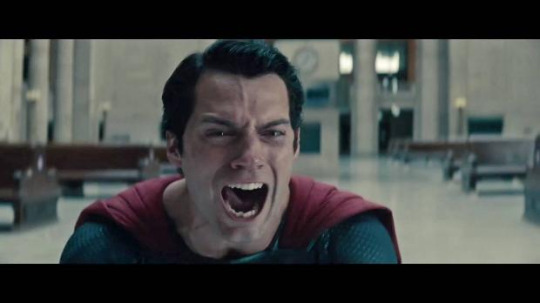
In the final analysis, beyond that mother of god is there sure no conceivable excuse for the treatment of Lois in this? The temptation is to join that anon and say as I originally tweeted that these were “built entirely to disabuse every single redemptive reading of the previous work and any notion of these movies as nuanced, artistic, self-reflective, or meaningful”.
...
...
...yeah, okay, that’s mostly right. Zack Snyder’s vision really was the vision of an edgelord idiot with bad ideas who was never going to build up to anything that would reframe it all as a sensible whole. He’s a sincere edgelord genuinely trying really hard with his bad ideas who put some of them together quite cleverly! But they’re fucking bad and the endgame was never anything more than ramping up into smashing the action figures together as big as he could, the political overtones and moral sketchiness of BvS while trying to say something in that movie reverberated through the grand scheme of his pentalogy in no way beyond giving his boys a big sad pit to rise out of so when they kicked ass later it’d rule harder, and all the gods among men questions and horror and trappings were only that: trappings. Apparently he’s really pleasant and well-meaning in person, but at his core his art as embodied in a couple weeks in his 4-hour R-rated Justice League movie meant to be seen in black-and-white all comes down to that time he yelled at someone on Twitter that he couldn’t appreciate Snyder’s work because it’s for grown-ups. He made half-clever, occasionally exciting shit cape movies for a bunch of corny pseudo-intellectual douchebags, folks latching onto and justifying blockbusters that at least acknowledge how horrifying the world is right now even if the superheroes are basically useless in the face of it if not outright part of the problem until a convenient alien invasion shows up to justify them, and a handful of non-asshole smart people who vibe with it but...well. ‘Suckered’ is a harsh word, and definitely doesn’t apply to all of them re: what they’ve gotten out of it up to this point and would (somehow) get out of this. But it doesn’t apply to none of them, either.
60 notes
·
View notes
Text
Michael in the Mainstream: Pokemon Generation I & II
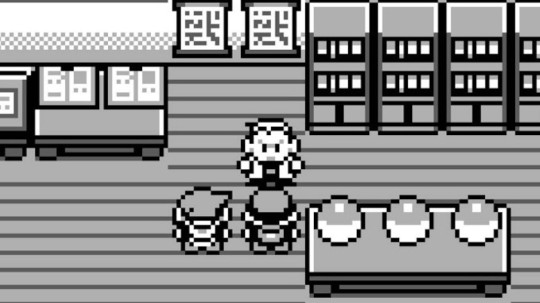
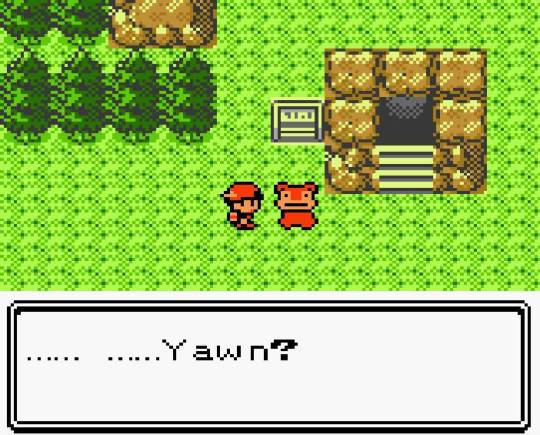
Pokemon is one of the biggest media franchises on the planet since 1996, and while it’s never exactly hit the same highs as it did back in the 90s, the franchise has been going strong for over two decades regardless. So, in honor of the latest entries in the franchise, I decided to take a look back at the old generations and look at what worked and what didn’t about them, though obviously in my own style. And what better place to start than the original two generations, Generations I and II?
Let’s start with Generation I, which includes the three games that started it all – Red, Blue, and Yellow, though back in the franchise’s homeland of Japan they had Green instead of Blue (hence why we got FireRed and LeafGreen, but no WaterBlue). These are the games that launched the franchise into the stratosphere of popularity, and for a long time they were held up as the gold standard of Pokemon games, attracting a die-hard base of “fans” known as Genwunners, who would bash anything outside of the first 151 Pokemon. Lately that sort of opinion has declined, though you still get the odd person here and there whining about how newer Pokemon designs look like Digimon, which indicates that the person saying that is unfamiliar with either franchise.
But what of the games themselves? What are they like? I have long expressed distaste for the Gen I games, mostly because of my hatred of Genwunners, but ultimately my opinions on the games are a lot more mixed. I do believe that Yellow is a genuinely good game and probably how the first generation should be experienced if you really want to go back to the old games, but my opinions on Red and Blue are a bit more mixed – but, shockingly, mostly positive.
You see, here’s the thing with Pokemon games – even at their worst, they’re still fun, and Red and Blue prove that. These are impressive games for their time that had the misfortune of aging far worse than a lot of their contemporaries, mostly due to the nature of the games themselves – any sort of franchise based on collecting and battling among groups of friends is going to need a lot of polish between releases, which will inevitably leave older games in the dust, especially when each generation after would add more and more Pokemon with each new generation. But even if they haven’t aged all too well, there’s still plenty of fun to be had here, though a lot of it is not in ways the creators intended.
Let’s get the bad stuff out of the way first – the balance in this game is absolutely atrocious. There are some types that are just objectively better than others, some types are so scarce as to be utterly useless, some moves don’t work like they’re supposed to, some of the computers use moves they shouldn’t know… the game is a hot mess, to put it lightly. At points the games feel frustratingly unplayable, especially when you come up against Sabrina, the gym leader wielding the all-powerful type of Gen I, Psychic.
The more mixed parts of the game are the story and the beloved, exploitable glitches. The story here… well, there isn’t one. There’s sort of an excuse plot in place - you have to beat all the gyms, challenge the Elite Four, and battle your rival (who you can name whatever, but I’ll be referring to him by his canon name, Blue). Other than that, though? There’s not really any sort of overarching plot. You kind of just wander into situation after situation on your way to the next gym. Even the whole Team Rocket plot here is mostly just you beating them up because they prove to slightly inconvenience you at every turn. Unlike in later entries, where the player is roped into saving the world from destruction at the hands of all-powerful PokeGods. Here the plot is basically “Young boy accidentally foils the Mafia while on a walk with their pet.” It’s so hilariously simple it’s hard to totally hate it, and to be perfectly fair a lot of early RPGs had rather simplistic plots, and this was one of the first handheld RPGs, so I cut them a bit of slack here, especially seeing as we at least got Giovanni out of this.
The glitches are infamous and iconic, but even them I’m a bit mixed on. Like, I love Missingno as much as everyone else, but I think tat if you need to break a game this hard to have fun, it kind of ruins things. I feel the same way about the glitches as I do the Crissaegrim in Symphony of the Night sure, they’re cool, flashy, and powerful, but they make the game so pathetically easy from that point onwards it just isn’t that entertaining anymore.
Still, this game does excel in one area: character. There are a lot of great characters in this game, human and Pokemon. A lot of the gym leaders are absolutely iconic, and the Elite Four is mostly interesting, though I will say that they lack a lot of character compared to later Elite Fours (though he Gen III remakes ameliorated this problem). It’s pretty impressive how so much character was able to be crammed into these characters even though they are ostensibly just roadblocks on your way to the next gym.
Then there are the Pokemon. The designs in this generation are pretty simple, occasionally to a fault, but there is a reason for this: a lot of Pokemon are based on yokai or tsukumogami, both of which are pretty essential in Japanese folklore. Tsukumogami in particular are something the franchise seems to absolutely love, with the Voltorb and Magnemite lines being notable examples from this generation. Other Japanese folklore represented in this Generation include kitsune, which the Vulpix line is explicitly based on, kappas, which Golduck is inspired by, baku, which the Drowzee line represents, and so in. In fact, the entire concept of Pokemon is so entrenched in the concepts of yokai and Japanese spirits that it is endlessly amusing to see Westerners nitpicking the designs, ignoring the cultural meaning behind them. Pokemon have a variety of inspirations obviously, but the weirder you think a design is the more likely it is to have been based off of some sort of yokai.
I think the definitive Gen I experience is Yellow, which is inspired by the anime. You start off with Pikachu who follows behind you at all times, you can acquire all of the starters, the game overall feels more polished (but not overly so), and you get to fight Jessie and James. It’s a lot of fun, and it doesn’t heavily alter the story, instead adding a few neat little additions, something that would become common with third versions in the franchise. The Kanto games are a solid start to a franchise, but they definitely could have used a bit more work…
That’s where Generation II comes in.
Generation II honestly feels like what Generation I should have been like, leaving Red and Blue as the unpolished alpha, Yellow as the beta, and Gold and Silver as the full release. In fact, it kind of leaves the second gen feeling a lot more like an expansion pack than anything else, but not in an obnoxious or bad way like a certain other game (COUGHOverwatch 2COUGH). These games are so much better in just about every conceivable way, it’s not even funny.
A lot of important series mainstays made their debut here. The biggest and best is probably the introduction of the Dark and Steel types, the latter of which really feels like it should have been in Generation 1 to begin with. Steel quickly established itself as a very defensive type, and Pokemon of that type are just naturally tough due to Steel resisting nearly every other type in the game, with it only being nerfed slightly once the games jumped to 3D. Dark on the other hand was extremely cool in concept, but a lot of the Pokemon of the type were not able to properly utilize their impressive movepools due to Dark being classified as a Special type and a lot of early Dark-types running with high physical stats.
Let me clarify real quick: prior to Generation IV, the type of the move determined whether it ran off of Physical or Special Attack, no matter how ludicrous it seemed. That means Dark moves like Bite and Fire moves like Blaze Kick ran off of the Special Attack stat despite almost always appearing on Pokemon that had much higher Physical Attack, leaving a lot of Dark-types in the dust until the Sinnoh games rolled along and balanced things. Still, this bump in usability did not stop Dark-types from being popular and beloved, with Pokemon like Umbreon, Sneasel, and Houndoom all debuting here in the land of Johto.
Speaking of new Pokemon, fewer were added this time around, only about 100, sort of fitting in with this game feeling like an expansion pack. A lot of the new Pokemon are odd and gimmicky, with strange creatures like Unown, Delibird, and Shuckle making their debut here, as well as the almighty Dunsparce. While time would be kind to some of these (Dunsparce and Shuckle in particular have gained niche uses and cult fandoms), other gimmicky Pokemon got left in the dust. Still, I do think having weird, gimmicky Pokemon adds some flavor to the world. If there’s one thing I am upset about, it’s some of the Pokemon that were cut from the game, revealed to the world in the prototype version of Gold and Silver that leaked online. We almst got a new Shellder evo that looked like Slowbro’s tail, as well as Pokemon like Lickilicky debuting two generations earlier (and with a far better design). Still, what we got is pretty impressive, and though I find Johto a tad bit vanilla, there are a lot of Pokemon I love in this generation.
Another great addition to the franchise is lore behind the Legendary Pokemon. Gen I did have a bit of lore in regards to Mew and Mewtwo if you chose to read all of the journals in Cinnabar Mansion, but the bird trio got nothing and sort of just felt like random bonus bosses than Pokemon really deserving the title of legends. In this game, every legend introduced feels legendary. Entei, Raikou, Suicune, Ho-Oh, and Lugia all have fascinating lore behind them, and while they don’t play a major part in the story or factor in to Team Rocket’s plans (save for Suicune in Crystal, who has its own subplot), it showed that even this early on they were working on making the legendaries feel bigger and more impressive to the point they deserved their title as legends.
Then of course there are the new additions to gameplay and collecting that helped really make the franchise shine. The introduction of held items is one of the most significant; now there were even more ways to improve your standing in a battle! Give your mon a berry, they’ll eat it when their health gets low! This feature would be expanded on in later games, but its start here introduced a whole new world of possibilities. There was also the splitting of the Special stat into Special Attack and Special Defense a choice that helped balance the games and not completely overpower the Psychic type. And speaking of, Type distribution was quite a bit better in these games, though the new types Steel and Dark as well as Ghost and Dragon were still fairly underutilized and rare.
Then there is the introduction of gender and breeding, which allowed players to get new Pokemon by leaving two Pokemon in the same egg group in a day care together. This not only allowed for the introduction of new baby Pokemon (which are largely useless and Pokedex filler if I’m being honest), but it gave the transforming blob of jello Ditto a new lease on life, as it could breed with absolutely ANYTHING, even some genderless Pokemon. Finally, we have the introduction of shiny Pokemon, Pokemon that had a different coloration than normal Pokemon and that almost surely existed to show off the power of the Game Boy Color. Back in Generation II, shinies were guaranteed to have perfect IVs of some sort or another to make their rarity more worthwhile, but this was scrapped after this gen. Still, there is nothing cooler than having that fabulous Pokemon with its incredible sparkle pop up while you’re roaming the wild, and nothing sadder than realizing you don’t have any balls to catch it.
The story here is also improved, which is a plus. A rarity for Pokemon games going forward, these games were true sequels to the originals, taking place a few years after the events of the Gen I games, and so the plot concerns the player getting roped in to not only stopping the remnants of Team Rocket trying to rise to power yet again, but also fighting off a mysterious rival named Silver, all while trying to complete the gym challenge. The stakes are a bit higher this time, but not overly so, and the plot definitely feels bigger and more important, with their being a sense of “I have to stop Team Rocket or something bad could happen” rather than “Ugh, these guys are blocking the way to the next gym, guess I better get rid of them.” And if that’s not enough, this has one of the more impressive post-games for the series… for its time. Much has been made of the late, great Satoru Iwata’s impressive cramming of the entirety of Kanto into the game, and you won’t hear me say that for the time these games came out what he did was impressive.
The thing is, this accomplishment has aged about as well as the games the Kanto region debuted in. Gen II’s version of Kanto has a very poor level curve, meaning you can basically steamroll through most of the gyms, and a lot of areas are blocked off, gone, or cut down. While it is cool to see all these places two years after the original games, it’s not nearly as fun when you’re crushing underleveled Pokemon and you can’t access Cerulean Cave or the legendary birds. When you finally acquire all the badges though, you get to head to Mt. Silver and make your way up to one of the definitive bonus bosses of the franchise – Red, the player character of the original games. He’s a pretty tough opponent, and the game seems to lean towards making Yellow the true canon game as Red has all three starters plus Pikachu,
There’s not much else to say, as there isn’t too much negative to say about the Johto region or the games. The definitive version is, of course, Crystal, as it has a bit of extra story and polish to it and even let you play as a girl for the first time, and though there are aspects that the remakes of these games would improve on, the Generation II games are actually extremely solid and a lot of fun to play to this day, even if they haven’t yet achieved optimal balance for Pokemon. At the very least, they’re a lot more fun and playable than the Gen I games.
It’s pretty undeniable that the first two generations put Pokemon on a pretty solid path of progression and started the franchise off with a bang. There was really nowhere to go from here but up, and boy oh boy did they ever go up from here.
#Michael in the Mainstream#Review#video game review#Pokemon#Red#Blue#Yellow#Gold#Silver#Crystal#Generation I#Generation II#Kanto#Johto#Team Rocket
16 notes
·
View notes
Photo
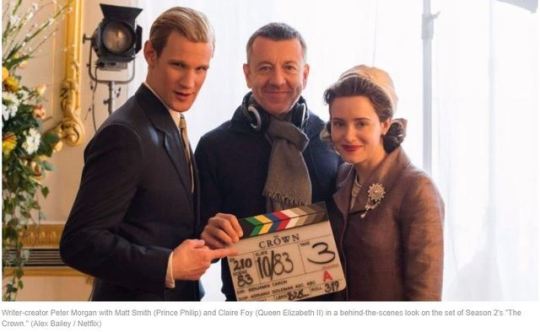
Netflix's 'The Crown' dives into the ups and downs of a power couple in Season 2
LA Times Dec 1, 2017
In early May, the queen arrived at Hornsey Town Hall in London. The 1930s building, now an arts center, was standing in for a hospital on the final episode of the second season of “The Crown,” which premieres Dec. 8 on Netflix. The queen was actually actress Claire Foy, dressed in a perfectly crisp suit. A crowd gathered outside, watching Foy enter and exit a vintage car over the course of several takes, each time trying to get her motions exact. Later, inside the building, director Ben Caron debated with the crew over exactly how the hospital workers would greet their monarch.
These details are the essence of “The Crown,” created and written by Peter Morgan. Even areas of the Town Hall that wouldn’t appear in any shots were made up like the hallways of a 1960s hospital, a reminder that the show’s attention to the minutiae is one of the reasons it’s become such a success worldwide.
The 10 episodes of Season 2 were filmed on 398 sets with approximately 6,500 actors and extras over the course of nearly eight months. Morgan admits that it was a struggle to get Season 2 completed on time with his specifications, despite the reported production budget of $100 million. “It was only because they were so kind and agreed to shoot anything I wrote,” Morgan said. “They begged me to do fewer locations, but I don’t seem to be able to do that.” He added, “I just think the more specific you are, the better it is.”
Season 2 opens in 1956, detailing the response to the Suez Crisis, and runs through 1963, concluding with the retirement of former Prime Minister Harold Macmillan following the Profumo Affair. For Morgan, the challenge was to highlight iconic events of that time while also digging deeper to uncover events lost to the past. It took Morgan and his team of researchers a year to conceive and write the episodes.
“That process takes me ages,” Morgan said. “It’s what I spend the longest time doing — really mapping out the whole season. Part of the process is avoiding making this feel like one of those ridiculous history programs. You realize that history is so reductive and what has become the official narrative of the 1960s only tells part of the story. What you want to do is find some unexpected stories each time without making it obtuse and weird.”
One of these forgotten stories emerges midway through the season. In 1957, John Grigg, also known as Lord Altrincham, wrote an article speaking out against the queen. It marked the first time anyone had really criticized the royal family in a public manner and caused a serious outcry.
“It’s a real point of change for her and a real point of weakness in her character,” Foy explained of Elizabeth. “She becomes very affected by how the public perceives her. That’s not something she’s ever had to deal with — being criticized — really. Suddenly to be criticized and have her voice and what she looks like become something that everyone’s talking about, that’s when she’s really vulnerable.”
For Foy, a central theme of this season is how the queen reacts — or doesn’t react. We see the issues in her marriage to Prince Philip (Matt Smith) and her tenuous relationship to her sister Margaret (Vanessa Kirby), but in public, the queen historically has put on a careful, considered demeanor, sometimes even to her own detriment.
“I realized that, although she seemingly can handle everything in a calm, considered, unruffled way, I think in this [season] you see the wheels come off,” Foy noted. “You see how difficult she finds things and that actually her way of dealing with it is not healthy. She needs to lose her temper. She needs to let it out more. There is a point to where she could face up to the situation that she’s in and admit it to herself, but that would be too costly to do that and too painful.”
Elizabeth’s relationship to Philip takes center stage throughout much of the season, particularly as the couple faces raising several young children while running the country. For Smith, the tensions between the two are among the most interesting moments.
“He’s got a huge conflict in him between his duty to his wife and his duty to himself as a man,” Smith said. “All the conflicts in his marriage are always quite satisfying to play because it’s quite a rich tapestry emotionally.” He added, of the historical accuracy, “It’s Peter Morgan’s version of what happens. There wasn’t a camera in there recording these things. It’s impressionistic, but it’s based on as much fact as we can gather.”
Those intimate moments between the couple are one of the reasons viewers gravitate to “The Crown.” The Windsor family is unique in position and stature, but they’re like any other family in many ways.
“Ultimately it’s about the relationships between a mother and a daughter, a man and a wife, two sisters,” said Smith. “It’s about relationships in a work environment. It’s about things that are universal in nature and therefore I think it speaks to different cultures and people in different places around the world.”
“It’s a uniquely successful marriage, but that doesn’t mean it doesn’t have its ups and downs,” Morgan added of Elizabeth and Philip. “In those stresses and strains, that we all experience, we can identify.”
For Foy, the appeal of “The Crown” is in the idea that a TV series doesn’t need an extreme premise to gain an audience. Although Netflix doesn’t release viewership numbers, it’s clear that the show has fans from multiple generations who connect to these key moments in time and relate to the royal family, even from afar.
“Sometimes you can make something beautifully and with real heart and truth and just make it really, really, really well,” Foy said. “I think people see that on-screen. They see it’s not a manipulation of them as an audience or trying to appeal to them every five seconds or trying to subvert anything every five seconds. And the idea of seeing behind the veil and seeing this family when you never normally would and getting to know them as people is why they have taken it to their heart.”
“There are very few human beings that are alive who haven’t had [Elizabeth] as a central iconic character in their lives,” Morgan added. “She binds together people internationally. Everybody has been conscious of this woman and her life and her position. The image of her face has been everywhere.” That face will change in Season 3, as new actors arrive to play the lead roles. So far only Olivia Colman has been cast to replace Foy for Seasons 3 and 4, after which another re-casting will take place for the planned final two seasons. Morgan’s intention was always to switch up the cast every two seasons, another instance of genuine detail. Colman was Morgan’s only choice to take over as Queen Elizabeth and according to him, she said yes immediately. She didn’t audition or read before being cast.
“It felt like a natural thing to do in the same way you see the queen’s portrait changing on the stamp,” Morgan noted. “It made sense to have somebody of the right age portraying her.”
Foy will miss the show, but has always been prepared for her inevitable exit. “We knew that from the very beginning,” the actress said. “These parts have already been reincarnated several times. I’m not the first person to play her. So that is in the nature of the story for them to carry on and change and evolve into someone else.”
The actress is aware of the power a show like “The Crown,” which reaches so many different people, can have. She doesn’t necessarily believe that we should look to the past for lessons, but Foy sees “The Crown” as a strong reminder that humanity does often reflect backward.
“It’s very important to look at what is happening now and think about how on earth it will be viewed in 60, 70, 80, 90 years and what future generations will think of the choices that we’re making now,” said Foy. “And what does it mean? What are the consequences of the decisions we’re making? Sometimes people could do with stepping back and going, ‘What is the message we’re trying to send out to our future generations about who we are now?’”
32 notes
·
View notes
Photo

GODZILLA - A QUESTION OF ORIGINS: AN ESSAY ON GODZILLA’S PLACE IN PALEO-FICTION
Earlier this month Toho Studios and Polygon Pictures unveiled to the world the latest incarnation of Godzilla via a 2-meter tall statue erected in the lobby of the Cinecitta’ Theater in Kawasaki. While this new version of Godzilla, which will appear in the forthcoming anime film GODZILLA: PLANET OF THE MONSTERS (Nov. 17, Dir. Kōbun Shizuno & Hiroyuki Seshita), has an overall familiar silhouette, it is also in many ways radically different from anything that has come before it. With a forest green complexion, skin which looks like twisted roots and leaf-shaped dorsal fins, this new Godzilla has a rather arboreal look to him.
A subsequent press release from Toho published on Sci-Fi Japan provided further confirmation regarding Godzilla’s Swamp Thing-like new look by noting that this incarnation of Godzilla will be a “plant-based” life form. Needless to say this statement was fairly vague and raised numerous questions as to what exactly is meant by “plant-based.” Will Godzilla actually be a plant or part plant? Will he be an animal with a symbiotic relationship to plants? Maybe it just means he’s a vegetarian? It’s still too early to say but this has not stopped many Godzilla fans from reacting with consternation and condemnation (at least on this side of the Pacific, I have no idea what Japanese Gojira fans are making of all this). Much of this outrage stems from the fact that most fans take as gospel the idea that Godzilla’s origin is that of an extant dinosaur whose exposure to radiation from atomic bomb tests in the Pacific in the 1950s mutated the creature into the familiar kaijū known around the world today.
But is this actually the case?
It should be stated upfront that Godzilla’s creator, Toho Studios producer Tomoyuki Tanaka, is on record as saying that he originally conceived of Godzilla as “a dinosaur sleeping in the Southern Hemisphere [that] had been awakened and transformed into a giant by the [atomic] bomb.” However, Tanaka gave his statement to The Washington Post in 1984, many years after the fact and while promoting the then new film THE RETURN OF GODZILLA (1984, Dir. Koji Hashimoto) which, as we will see, was the first in a series of Godzilla movies which began placing greater emphasis on Godzilla’s connection to dinosaurs. Furthermore, digging into the production of the original Godzilla film from 1954 reveals that there was in fact no consensus early on regarding what exactly Godzilla should be. Special-effects director Eiji Tsuburaya campaigned for Godzilla to be a giant octopus while early concept art by cartoonist Kazuyoshi Abe depicted a monster more allegorical then biological in appearance, as it resembled an anthropomorphic living-mushroom cloud. It wasn’t until Toho art director Akira Watanabe took a pass at the design that Godzilla’s now familiar dinosaurian look began to emerge. However this essay is not interested in events which transpired behind the scenes but rather those which ended up in front of the cameras. In other words, the question being asked here is if the commonly upheld assertion that Godzilla is a ‘radioactive dinosaur’ can actually be found in the 31-films which make up Godzilla’s current cinematic legacy. To this end, the following essay will look at those films in the franchise which both explicitly and implicitly deal with the subject of Godzilla’s origin in order to find out what is and is not actually said about the King of the Monsters and where he comes from.
As a final note before proceeding it should be observed that because the role of science in science-fiction films is often to merely lend a veneer of scientific veracity to the events on screen via the use of technical sounding jargon it should not be expected that the paleontological claims made by various characters in the Godzilla films are in any way accurate or a reflection of what actual paleontologists have ever thought was true about dinosaurs. Nevertheless, there are moments in the franchise where actual paleontology – both cutting edge and hopelessly out-of-date – has been invoked, balanced out by scenes of utter pseudoscience. Because of this fact, this essay will endeavor to highlight which ideas are true, which are blatantly false and which fall somewhere in between. What this essay will not attempt to do however is use the tenants of contemporary paleontology to try and explain Godzilla’s origin – mostly because I am not a paleontologist. Readers who are interested in that kind of speculation have a number of essays on this very topic written by actual paleontologists including Kenneth Carpenter, Darren Naish, and Mark Witton which they should consult. Now on to the films…
Godzilla (1954)
In GODZILLA (1954, Dir. Ishiro Honda) Japanese fishing trawlers begin mysterious disappearing off the coast of Japan. When some of the survivors wash up on the nearby Odo Island journalist Hagiwara (Sachio Sakai) goes to investigate. He learns that the locals blame the disasters on a mythical monster called Gojira/Godzilla and that night, during a storm, Hagiwara briefly spies the beast. In response to Hagiwara’s report the Japanese government dispatches a team of scientists to investigate including paleontologist Dr. Kyohei Yamane (Takashi Shimura). Once on Odo Island, Dr. Yamane observes huge saurian footprints crisscrossing the terrain and discovers a living trilobite – a kind of extinct marine arthropod – in one of them. He also notes that the footprints are highly radioactive. Dr. Yamane isn’t on the island long when Godzilla reappears – this time in broad daylight – peeking over a nearby cliff before disappearing back into the sea. Based on his discoveries and observations Dr. Yamane returns to Tokyo where he delivers the following statement to government officials…
“About 2-million years ago, this brontosaurus and these other dinosaurs roamed the earth during a period the experts called Jurassic. During the following geological period, the Cretaceous, a creature somewhere between the marine reptiles and the evolving terrestrial animals was born. I am convinced there was such an intermediate creature. [Brings up photo of Godzilla to audible gasps from the audience] This creature, according to Odo Island folklore, is called Godzilla. As we look at this photo of Godzilla’s head from a hill on Odo Island, we can estimate that this creature stands approximately 50-meters tall. So then, how can we explain the presence of such a creature during the present day? It probably survived by eating deep sea organisms occupying a specific niche. However, recent experimental nuclear detonations may have drastically altered its natural habitat. I would even speculate that a hydrogen bomb explosion may have removed it from its surroundings.”
Dr. Yamane continues to elaborate upon his theory, showing off the trilobite he recovered from Godzilla’s footprint and explaining that the sand extracted from its shell is the same as that found in Jurassic era fossil deposits. This same sand also contained traces of “Strontium-90” a radioactive isotope “generated only from an atomic bomb.”
While Dr. Yamane’s never overtly declares that Godzilla is a ‘radioactive dinosaur’ his references to “brontosaurus and… other dinosaurs” – words accompanied by slides showing acclaimed paleoartist Rudolph F. Zallinger’s paintings of dinosaurs – strongly suggests the idea. More specifically, Dr. Yamane appears to believe that Godzilla represents a transitional form between terrestrial dinosaurs and marine reptiles (i.e. plesiosaurs, pliosaurs, ichthyosaurs and mosasaurs); a notion which is phylogenetically erroneous though perhaps not quite as egregious as the blatantly false assertion that non-avian dinosaurs were roaming the earth as recently as 2-million years ago.
Godzilla: The Shōwa Era (1955-1975)
As the Godzilla series progressed, emphasis on the question of Godzilla’s origin was gradually sidelined. Dr. Yamane returns in the franchise’s second film, GODZILLA RAIDS AGAIN (1955, Dir. Motoyoshi Oda), just long enough to confirm the Japanese government’s fears that a second Godzilla has been discovered following the death of the first one in the 1954 film. To make matters worse a second kaijū, Anguirus, has also appeared and been identified by another scientist, Dr. Tadokoro (Masao Shimizu), as a type of Ankylosaurus.
What is interesting to note here is that while the Japanese films chose to deemphasize Godzilla’s possible dinosaurian origins, the American localizations of these same films insisted on actually putting more emphasis on such ideas via additional dialogue added either through dubbing or the insertion of new scenes. For example, in Warner Brother’s reworking of GODZILLA RAIDS AGAIN, re-titled GIGANTIS THE FIRE MONSTER for US audiences, Dr. Yamane and Dr. Tadokoro’s brief bout of exposition is expanded into a nearly 7-minute long spiel featuring some of the most outrageous pseudoscience ever committed to screen in a 50s B-monster movie… or possibly anywhere else. Highlights include Dr. Yamane declaring that dinosaurs “were born out of fiery matter, their very existence was based upon the element of fire. They breathed fire, they survived in fire, fire was part of their organic makeup” and Dr. Tadokoro reading, allegedly out of paleontological textbook, an excerpt which reports that “somewhere, although it is not known when, these creatures may come alive after years of hibernation due to radioactive fallout.”
Universal’s 1963 Americanization of KING KONG VS. GODZILLA (1962, Dir. Ishiro Honda) fared no better. New scenes where added featuring United Nations reporter Eric Carter (Michael Keith) interviewing Dr. Arnold Johnson (Harry Holcombe), head of the Museum of Natural History in New York, who uses a copy of writer Darlene Geis and artist R.F. Peterson’s children’s science book Dinosaurs and Other Prehistoric Animals (1959) to explain that Godzilla is a hybrid between a Stegosaurus (a late Jurassic era, Ornithischian, herbivorous quadruped) and Tyrannosaurus Rex (a late Cretaceous era, Saurischian, carnivorous theropod). The mind reels.
Godzilla: The Heisei Era (1984-1995)
While the question of Godzilla’s origin quickly faded into the background during the Shōwa era, Toho’s second series of Godzilla films would revive the issue, placing new emphasis on the question and ultimately delivering what is to date the most detailed account of Godzilla’s dinosaurian beginnings.
In THE RETURN OF GODZILLA (1985, Dir. Koji Hashimoto), Godzilla’s sudden return after a nearly 30-year absence throws the Cold War powers of the United States and Russia into a tailspin with Japan serving as a reluctant middleman. Brash, young reporter Goro Maki (Ken Tanaka) has the inside scoop but is barred by the Japanese government from publishing his report due to concerns that the revelation that Godzilla is alive and well may cause an international panic. Maki then visits biologist Prof. Makoto Hayashida (Yosuke Natsuki) to learn more about Godzilla. Like Dr. Yamane, Prof. Hayashida never openly declares that Godzilla is a ‘radioactive dinosaur’ but the insinuation is clearly there. Prof. Hayashida’s lab is full of miniature fossil skeleton models of various extinct species and a coffee table in the room is covered with books on dinosaurs. When Maki asks the professor if he thinks Godzilla is a biological animal, Maki says yes but clarifies that due to his exposure to radiation Godzilla has been transformed into a “living nuclear weapon.” Prof. Hayashida then passes Maki a copy of David Lambert’s book Dinosaurs (1978) while intoning that he has also come to believe that Godzilla is “immortal” – the implication here being that Godzilla is not only an extant dinosaur but one which possibly has been around for millions of years.
This idea is further bolstered by Prof. Hayashida’s eventual plan to defeat Godzilla. Noting that Godzilla appears to follow the same migratory routes as modern birds, which are the evolutionary descendants of dinosaurs, Prof. Hayashida theorizes that Godzilla has a similar “homing” instinct to birds and that if they can find a way to manipulate this then they can effectively trick Godzilla into going where they tell him to, including having him walk straight into the mouth of an active volcano – which is exactly what they do!
Of course, Godzilla doesn’t stay there and eventually escapes for a sequel, GODZILLA VS. BIOLLANTE (1989, Dir. Kazuki Ohmori), which doesn’t feature any paleontological content. However, its sequel, GODZILLA VS. KING GHIDORAH (1991, Dir. Kazuki Ohmori), does being the first and so far only film in the franchise to reveal the origin of Godzilla on screen.
The plot of GODZILLA VS. KING GHIDORAH involves time-travelers from the year 2204 who come back to warn the Japanese that in the near future Godzilla will destroy the country of Japan entirely. In order to prevent this the time-travelers propose going back to the year 1944 and locating the extant dinosaur that would become Godzilla and moving it to another island in the South Pacific where it won’t be exposed to radiation from atomic bomb tests - thus negating Godzilla’s entire existence. The only problem however is that the time-travelers don’t know what island the dinosaur is on, which is why they have come to the year 1992 to find science-fiction writer Kenichiro Terasawa (Kosuke Toyohara) who is currently writing a book about Godzilla’s origin with the help of a scientist named Prof. Mazaki (Katsuhiko Sasaki) who has previously published a monograph in which he argues against the scientific consensus that dinosaurs went extinct 66-million years ago. Based on eyewitness accounts from surviving Japanese soldiers stationed on Lagos Island during the Gilbert and Marshall Islands campaign, Terasawa has concluded that a living dinosaur was present on the island and theorizes that this same dinosaur was subsequently mutated into Godzilla. Terasawa, Prof. Mazaki, and several other characters, join the time-travelers and journeys back to 1944. There on Lagos Island they witness the dinosaur, which Terasawa unoriginally dubs Godzillasaurus, fight off an American military platoon thereby saving the Japanese troops stationed on the island.
One of the most curious aspects about this whole scenario regarding Godzilla’s origin is the way in which the surviving Japanese soldiers come to revere and worship Godzilla as Japan’s savior. Early on in the film we see Terasawa interviewing a veteran named Masukichi Ikehata (Koichi Ueda) who has just managed to get himself kicked out of a natural history museum for walking around with banners and a megaphone declaring that…
“A long time ago, I saw a real-life dinosaur. You don’t know what it was like, but I certainly do! That dinosaur is always watching us from somewhere. And if we ever become helpless and desperate… Right when we’re about to be broken, the dinosaur will always come. A warning to the humans who desecrate the dinosaur. The dinosaur are sacred. Hear the voice of the dinosaur. I encountered it on the doomed battlefront of the War.”
Less extreme is wealthy business tycoon Yasuaki Shindo (Yoshio Tsuchiya), who was also stationed on Lagos Island in ’44 and witnessed the dinosaur, an incident which has led to an apparent life-long obsession with dinosaurs to the point that Shindo’s corporate office is filled with model dinosaurs and a huge dinosaur mural hangs on the wall behind his desk.
Takayuki Tatsumi, who is a real-world professor of literary theory and American literature at Keio University, writes that such devotion as displayed by Ikehata and Shindo recalls the practices of Ōishigori Shintoism which was a splinter sect of the Japanese national religion of Shinto which is an animistic faith that teaches the worship of nature as an embodiment of the divine. Ōishigori Shintoism, pioneered by Meiji era clairvoyant Ōishigori Masumi (b. 1832 – d. 1913) – who feared that Shinto was falling behind the rival religions of Christianity and Buddhism as well as then cutting-edge scientific thought such as Darwin’s Theory of Evolution – conversely taught that the Japanese were not the evolutionary descendants of early hominids but rather arose from dragons born of stone pebbles filled with chi by the gods. According to Ōishigori these “dragons” – the ones mentioned in Shinto texts like the Kojiki and Nihon-Nihongi – were actually extant dinosaurs. Furthermore not all the dinosaurs had evolved into humans. Rather some had remained hidden deep in the sea where they lived on as Dragon Gods. Either way, what Ōishigori was ultimately advocating was a worldview in which the Japanese are both the descendants of dinosaurs and worship dinosaurs as living-gods.
Having explicitly established Godzilla’s status as a living dinosaur, the fifth film in the Heisei series sees this information put to use. A scientific expedition lead by Prof. Ohmae (Yûsuke Kawazu) to Adona Island in the Bering Sea – which is described by one character as a “nuclear junkyard” – leads to the discovery of the mutant pteranodon Rodan and the recovery of a gigantic unhatched prehistoric egg. Prof. Ohmae initially believes the egg is Rodan’s, but is proven wrong when it eventually hatches revealing an infant Godzillasaurus. By studying this creature the scientists at the United Nations Godzilla Countermeasures Center (UNGCC) learn that Godzilla’s species has two brains; one located in the skull and another at the base of the spine. Using this knowledge they plan to attack Godzilla’s second brain with hopes paralyzing the monster.
The idea that Godzilla would have two brains may seem odd but is actually based on a real-life theory about dinosaurs developed by acclaimed and controversial 19th-Century Yale paleontologist Othniel Charles Marsh who observed that many of the biggest dinosaurs – specifically sauropods and stegosaurus – had an unusually large medullar cavity in the sacropelvic region of their bodies. Because the heads of these giant dinosaurs seemed so absurdly small for their massive bodies Marsh concluded that this sacral cavity must have housed a second brain which worked to control the back half of their bodies while the one in their skulls controlled the front half. Marsh’s double-brain hypothesis was eventually overturned and paleontologists now believe that such cavities housed rich stores of glycogen rather than extra grey matter. Nevertheless the myth of the two-brained dinosaurs persists to this day popping up as recently as 2013 when it was invoked by scientist Dr. Newton Geiszler (Charlie Day) in the film PACIFIC RIM (Dir. Guillermo del Toro).
Godzilla (1998)
The origin of the Godzilla which appears in 1998’s GODZILLA (Dir. Roland Emmerich) is a matter of some controversy. After a destroyed Japanese fishing boat washes ashore in Panama with a series of huge saurian footprints leading away from it, the US military assembles a team of scientists to assess the situation and determine what kind of creature might be responsible. Among the team is paleontologist Dr. Elsie Chapman (Vicki Lewis) who early on deduces that they are dealing with an extant “Theropoda Allosaurus;” a theory which is met with skepticism by her teammates Dr. Nick Tatopoulos (Matthew Broderick) and Dr. Mendel Craven (Malcolm Danare). In Stephen Molstad’s adult novelization of the film, Dr. Craven, in particular, raises a number of objections to Dr. Chapman���s contention that Godzilla is a living dinosaur including the issues of how it would have survived the K-T mass extinction, why no one has seen it before now, that it is hailing from the wrong part of the globe (Allosaurus fossils are found in the American West, not the South Pacific), and the fact that theropod dinosaurs are not generally believed to have been amphibious.
However despite these serious objections neither Dr. Craven nor Dr. Tatopoulos are ever actually capable of refuting Dr. Chapman’s contentions and it does not appear that Dr. Chapman herself ever abandons them. In fact, it would appear that both of her colleagues may have later actually come to agree with her. Evidence of this is found in Molstad’s novelization where we learn that Dr. Craven eventually authored a book about Godzilla called Cretaceous-period Park; a title which suggests a belief that Godzilla is a relic dinosaur. Furthermore in the pilot episode of the animated GODZILLA: THE SERIES (1998-2000, 40 Episodes), Dr. Tatopoulous discovers a baby Godzilla in the sewers of New York. The infant imprints on him (like a bird) and comes to believe he’s its parent. When his colleagues learn about this second Godzilla they initially want it destroyed leading Dr. Tatopoulous to plead with them to allow the creature to live, at one point saying to Dr. Chapman: “You’re a paleontologist. Why would you destroy your only living specimen?”
The alternative theory as to this Godzilla’s origin is that it is a mutated version of a contemporary reptile; either a marine iguana or a member of the Varanidae family which includes both monitor lizards and Komodo Dragons. The opening credit sequence of the 1998 film alludes to such an origin via its juxtaposition of images of South Pacific reptiles and atomic bomb detonations. Additionally this is the pet theory of Dr. Tatopoulos, having come to him, according to Molstead, in the form of a recurring nightmare. In H.B. Gilmour’s junior novelization of the film this theory is all but validated by the book’s opening page which describes a scene set in “June 1968” in which the eggs of a “six-foot-long reptile” living on an island in the Pacific are exposed to the fallout from an atomic bomb test. [1]
Godzilla: The Millennium Series (1999-2004)
Toho’s third series of Godzilla films would once again sideline the issue of Godzilla’s origin, be it prehistoric or otherwise. The movie which proves the exception to this rule however is 2001’s GODZILLA, MOTHRA, KING GHIDORAH: GIANT MONSTER’S ALL-OUT ATTACK (Dir. Shusuke Kaneko) which is notable for not only tackling this issue but in doing so also effectively appearing to tear down and dismiss everything which had previously been established about what Godzilla is and where he comes from.
In the film, the ghost of folklorist Prof. Hirotoshi Isayama (Hideyo Amamoto) prophesies Godzilla’s return. He also explains that Godzilla is the embodiment of “the souls of countless people who fell victim to the Pacific War” and who have returned to attack Japan “because people have forgotten… Forgotten the agony of those killed in the war… Forgotten their cries…”
In making the claim that Godzilla is the personification of the restless spirits of those who died during WWII, Prof. Isayama is essentially positing that Godzilla, rather than being a biological entity, is a supernatural one, specifically an onryō, or vengeful spirit, like those seen in such Japanese horror movies as RING (1998, Dir. Hideo Nakata), PULSE (2001, Dir. Kiyoshi Kurosawa) and JU-ON: THE GRUDGE (2002, Dir. Takashi Shimizu). While such an interpretation may appear to be totally out of left field, it actually reflects a widespread interpretation of Godzilla which became popular among real-world Japanese folklorists – such as Akasaka Norio and Nagayama Yasuo – and film critics – like Yomota Inuhiko – in the late 1980s and early 1990s. Such an interpretation would also appear to be about as far removed from the understanding of Godzilla as ‘mutant dinosaur’ as one can get.
However, as mentioned earlier in conjunction with GODZILLA VS. KING GHIDORAH (1991), such a theory also raises the specter of Ōishigori Shintoism again and the idea that the Japanese are somehow both spiritually and evolutionarily related to dinosaurs. How else do you explain why the souls of dead Japanese soldiers would manifest in the form of a huge dinosaurian monster like Godzilla?
Godzilla (2014)
Much like its depiction of the monster itself, the second American-made Godzilla film, GODZILLA (2014, Dir. Gareth Edwards), does a good job of obfuscating the issue of Godzilla’s origin. Despite having presumably spent their entire careers studying this creature and others like it, biologists Dr. Ishiro Serizawa (Ken Watanabe) and Dr. Vivienne Graham (Sally Hawkins) are only willing to say that Godzilla is “an ancient alpha predator… Millions of years older than mankind, from a time when the earth was ten times more radioactive than it is today.” It is unclear exactly what geological time period the scientists are referring to here. Earth has frequently been bombarded by cosmic radiation throughout its 4.5 billion-year history leading to periods when the planet was indeed “more radioactive than it is today” (though only 10x more seems to be low-balling it). This could mean that Godzilla came about as far back as 2.5 billion to 3 billion-years ago – which seems unlikely since the only known life on the planet at this point was photosynthetic bacteria – or as recently as 1.7 million-years ago when our hominid ancestor Paranthropus Robustus was walking the plains of Africa.
However, the movie’s official prequel comic, Godzilla: Awakening written by the film’s scriptwriter Max Borenstein alongside his brother Greg, has a much younger Serizawa claim that Godzilla and his fellow Massive Unidentified Terrestrial Organisms (or MUTOs) originate from the Permian Period which ended roughly 252.2 million-years ago. If so this would disqualify Godzilla from being a dinosaur since dinosaurs did not appear until after the Permian Mass Extinction, known colloquially as the Great Dying, which was the largest mass extinction in Earth’s history resulting in the end of nearly 90% of all marine species and 70% of all terrestrial species. It would also contradict Dr. Serizawa and Dr. Graham’s later contentions that such creatures thrived in an intensely radioactive environment since there is no evidence to suggest that the earth was particularly radioactive during this time.
While Monarch’s scientists may be unsure of what Godzilla is, protagonist Ford Brody’s son Sam knows a dinosaur when he sees one and proudly identifies Godzilla as such when he first spies the creature on television. Likewise in Greg Cox’s novelization of the film, Ford (Aaron Taylor-Johnson) finds himself thinking that Godzilla resembles “some unknown species of dinosaur” despite the fact that it is “at least thirty times larger than even a Tyrannosaurus rex.”
Shin Godzilla (2016)
The most recent live-action Godzilla movie from Toho Studios, SHIN GODZILLA (2016, Dir. Hideaki Anno & Shinji Higuchi), spends the most screen time since the Heisei era elaborating upon Godzilla’s hypothetical biology and offering up an explanation for everything including his dorsal fins which are theorized to help regulate body temperature; a popular theory also proposed about Stegosaurus’ iconic back plates. The film also explores Godzilla’s origin via data discovered in an envelope found by the Japanese Coast Guard in an abandoned yacht drifting in Tokyo Bay at the beginning of the movie
Eventually the yacht is identified as having belonged to Prof. Goro Maki (Kihachi Okamoto), who is presumed to have committed suicide prior to the start of the film. A quick glance at Prof. Maki’s CV shows that he specialized in Integrative Biology and additional information discovered by the film’s protagonists reveals that following his wife’s death in an unspecified nuclear accident (possibly the Fukushima Daiichi disaster?), Maki abandoned his job as a Japanese college professor and went to work for the United States Department of Energy. There Prof. Maki focused his research on the effects of nuclear waste dumped by the US on the South Pacific Ocean floor. He eventually discovered that the waste was being fed upon by a certain marine organism which had mutated into the creature that would eventually become Godzilla. Prof. Maki’s report was subsequently suppressed by the US government.
Though it is not stated in the film what kind of marine organism Prof. Maki believed had fed on the nuclear waste, a five page English language essay titled “Inventory of Radioactive Material Entering the Marine Environment” found in The Art of Shin Godzilla making-of book and attributed to Prof. Maki reveals that the scientist had concluded that the culprit was “most likely… a prehistoric marine reptile” either a Mosasaurs or an Ichthyosaurus. Like Dr. Yamane, Prof. Maki seems to have also believed that such a creature would represent a transitional form between Mesozoic marine reptiles and dinosaurs, or at least that is what one is left to conclude from the otherwise paleontological non-sequitur that is Prof. Maki’s declaration that “any ichthyosaur that is the size of a chicken or larger would be recognized as a dinosaur.”
Godzilla: Monster Planet (2017) and Beyond…
Due to the respective domestic and international box office success of GODZILLA (2014) and SHIN GODZILLA (2016) both Hollywood and Toho Studios in Japan have committed to producing a slate of new films in the Godzilla franchise. This includes at least two more films in what Legendary Pictures is calling the MonsterVerse cinematic universe that already includes GODZILLA (2014) and this year’s KONG: SKULL ISLAND (Dir. Jordan Vogt-Roberts). It is unknown if these two new films, GODZILLA: KING OF THE MONSTERS (2019, Dir. Michael Dougherty) and GODZILLA VS. KONG (2020, Dir. Adam Wingard), will attempt to elucidate the murky origin of the second American Godzilla but if KONG: SKULL ISLAND, which did a great deal to clarify various aspects of the MonsterVerse’s underlying mythology, is any indication they probably will.
However, as mentioned at the top of this essay, the next theatrical film which fans can look forward to will be the animated GODZILLA: PLANET OF THE MONSTERS from Toho and Polygon Pictures and which will debut in Japan this November before heading to Netflix for worldwide distribution either late this year or early next year. As noted this new film has raised the possibility of botanical-based King of the Monsters, an idea which strikes many fans as anathema. For this contingent of fans Godzilla is a dinosaur, both now and forever. What this essay has attempted show however is that while the idea that Godzilla is a mutant dinosaur, or some other kind of similar prehistoric reptile, is one which has been present throughout the franchise’s 60+ year history it is also not one which has been clear or consistent in its fundamental contentions.
Perhaps the key here is to think about the idea of Godzilla as dinosaur not in a strict scientific sense but rather in a symbolic one. As I often remind my students when doing my class on dinosaurs in popular-culture, much of the dinosaur’s power come from the fact that they are inherently liminal entities. This means that they exist simultaneously between two conflicting states of being. In the case of the dinosaurs their liminality arises from the fact that they are simultaneously both real and imaginary. They are real because we have their bones, we know they existed. But they are also imaginary because no human has ever seen one and so we must be content to use our imaginations to tell us what they were like. This fact transforms dinosaurs into a potent symbol. An empirically verifiable fantasy. In this way Godzilla, as dinosaur, lays claim to a status that other more purely fantastic creatures cannot. IMAGE: Godzilla, having laid waste to the cities of man, welcomes back his saurian brethren in artist Pete Von Sholly’s “The Return” (2014)
[1] It is also possible that both Dr. Chapman and Dr. Tatopoulous’ theories are incorrect or, perhaps, only partially correct. In the same pilot episode of GODZILLA: THE SERIES a subsequent scene featuring both scientists find Dr. Chapman noting that many of Godzilla’s behaviors fly in the face of conventional notions about “carnivorous dinosaurs,” while Dr. Tatopoulous concedes that Godzilla does not behave “like a lizard” either.
#dinosaur#dinosaurs#dinosaur movies#godzilla#shin godzilla#godzilla 1954#the return of godzilla#godzilla 2014#godzilla 1998#godzilla vs king ghidorah#godzilla vs king kong#godzilla monster planet#godzilla mothra and king ghidorah: giant monsters all-out attack#godzilla planet of the monsters#anime
247 notes
·
View notes
Text
SUMMARY Dr. Jane Tiptree has withdrawn from public life to conduct sequestered research for the Eunice Corporation. The DARPA is wary of her work with genetically modified chickens but cannot legally interfere in her research. While in transport, one of Tiptree’s chickens hatches a reptilian creature which kills the driver and escapes. Meanwhile, near her laboratory in the small town of Climax, Nevada, the populace begin suffering from a mysterious illness with flu-like symptoms.
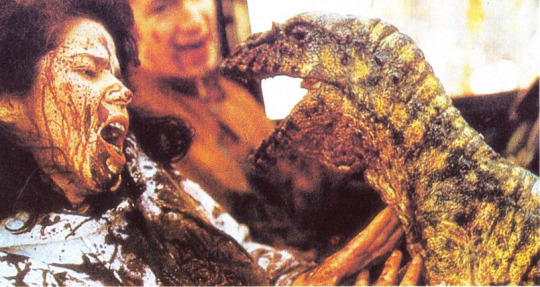
At a neighboring Eunice-owned quarry, watchman Doc Smith protects excavation equipment from environmentalists. He reports a trespasser, Ann Thrush, but Sheriff Fowler is investigating a series of gruesome killings, perpetrated by Tiptree’s missing creature, a Deinonychus. Among the victims is the daughter of Eunice employee Jesse Paloma, but before he raises any suspicion to her research, Tiptree lures him into a laser-protected dinosaur pen where a fully grown Tyrannosaurus rex devours him.
Despite the deaths, Thrush and a group of activists handcuff themselves to excavation equipment in a form of protest. They are encountered by the Deinonychus and everyone except Thrush is slaughtered. Still in shock, Thrush is brought back by Doc to his trailer, where she survives another attack by the creature. Doc discovers a truck with two corpses belonging to Eunice and contacts Tiptree on the vehicle’s radio, deducing the creature originated from her facility. As he approaches the lab, Fowler discovers a dinosaur embryo in a carton of eggs and takes it for investigation.

Doc infiltrates Tiptree’s laboratory and, at gunpoint, she reveals her experiment subjects to him. The town’s mysterious illness is caused by infected chicken eggs, which contain a lethal airborne virus and impregnate women with dinosaur embryos. Her objective is to exterminate the human race, which Tiptree faults as disastrous, and enable dinosaurs to repopulate the Earth. News of the town’s deaths reach Eunice sponsors who trace it to Tiptree. In response, the government places the community under quarantine and resolves to kill civilians — infected or not — on sight.
With the illness rapidly spreading, Fowler responds to a disturbance at a kennel. He confronts the Deinonychus, but both he and the creature suffer fatal wounds in the exchange. Top governmental officials, in a secure underground bunker, also begin plotting the repopulation of the human race in response to the virus; they envision a new social order prograted by strict fertilization policies and artificial wombs. At the laboratory, Doc attempts to escape with a cure to the illness and mistakenly enters the dinosaur pen. Tiptree releases the T. rex which pursues Doc out of the facility. Infected herself, Tiptree births a dinosaur and succumbs to the illness.

Doc returns to Thrush, who has been exposed to the illness. The T. rex enters the quarry where Doc battles the creature using a Backhoe loader, impaling and killing the creature with Thrush’s assistance. After injecting her with the serum, Doc is killed by government soldiers alerted to his presence, and both his and Thrush’s bodies are burned.
youtube
DEVELOPMENT/PRODUCTION When Roger Corman offered the job of writing and directing the dinosaurs vs. mankind epic Carnosaur to Adam Simon, the filmmaker leapt at the chance for a number of reasons. Not the least of these was the opportunity to avoid what he sees as a curse.
“The curse of any young filmmaker is that if they turn anything down, they are doomed to direct its sequel,” laughs Simon. “Right after I did Brain Dead, I was offered the original Body Chemistry and turned it down. Guess what I ended up directing? Body Chemistry 2. That’s why I jumped at Carnosaur, because if I didn’t, I knew I’d end up directing Carnosaur 2.”
Having survived the arduous schedule that typifies a Concorde production (“18 days, 18 hours a day”), Simon is in the editing phase of Carnosaur, Corman’s low-budget (rumored to cost under $1 million) answer to the megabuck contender Jurassic Park. The director’s immediate future entails a week of minor reshoots and miniature work and four weeks of editing en route to a scheduled theatrical release in June. But the good-natured Simon feels his experience on the aforementioned Corman films will help him handle the crunch.
This slideshow requires JavaScript.
“The biggest danger I face at this point is working so many long days and so many long hours that, all of a sudden, I’ll lose perspective. That’s the stage I’m in right now. But the big difference is that I’m going through this with Roger for the third time, so I’m able to relax and just trust in the process.”
The writer/director is philosophical about the fact that he “essentially had one foot out of Concorde and had started some outside writing projects” when Corman called with the Carnosaur assignment. The producer had originally purchased the rights to the novel, a tongue-in-cheek tale of dinosaurs brought to life in the present day written by British author Harry Adam Knight (a pseudonym for John Brosnan), in 1990. When the Spielberg-driven Jurassic Park loomed on the horizon, Corman gave Carnosaur a go in 1992. But after three drafts of the script (including one written by Knight himself) failed to set Corman’s flesh crawling, he called upon Simon, who was more than ready to accept.
One might speculate that Ladd’s involvement with Carnosaur is somehow connected to the fact that her daughter, Laura Dern, stars in the competing Jurassic Park. But Simon reports that the actress, who worked a total of five days on the film, agreed to appear for other reasons. “She did it partly as a hoot, and partly because she had an unwritten agreement with Roger,” he says. “Because he had given her and former husband Bruce Dern breaks early in their careers, she agreed to come back and do another film for him if the project and the situation seemed right.
“I had basically reached a point where I had been spending a lot of time knocking on major studio doors and having nothing come out of it,” confesses Simon, who cameoed, using his real name as a struggling screenwriter in last year’s acclaimed The Player. “I felt like I was too young to be sitting on my ass and not doing anything. So I decided to stop worrying about when the big studios were going to notice me and just do my own thing. And that’s about the time Roger called with Carnosaur.
“I loved the idea of doing a classic dinosaur movie, and I had never really worked with effects and creatures before,” he continues. “It also didn’t hurt that Roger was giving me a lot of time and freedom to write the script.”
But in exchange for those luxuries, Simon relates that he had to make what he calls “a Faustian bargain” with the producer. Although Corman required that only the title be retained from the novel, he insisted that the film feature genetically engineered dinosaurs, one of which had to be a Tyrannosaurus rex. Simon agreed and, in preparation for the task, read Knight’s book.
“I loved the tongue-in-cheek nature of the novel,” he admits. “The problem was that it was very campy, and while I didn’t mind this kind of film being funny, I definitely didn’t think the movie should be camp. I wanted humor, but not a parody.”
“It’s a very similar premise,” noted CARNOSAUR producer Roger Corman of the competition, JURASSIC PARK. CARNOSAUR is also about genetically engineered dinosaurs, but the veteran producer, with a completely straight face, brushed aside any charge of plagiarism against JURASSIC PARK. “Our film is from a novel written eight or nine years ago by Harry Adam Knight. I don’t know whether Michael Crichton or Steven Spielberg ever read Carnosaur. I don’t think he took the idea from Carnosaur. It was probably an original idea with him and he didn’t even know that Harry Adam Knight had written a similar story.”
Knight is actually the pseudonym of English film journalist John Brosnan who authored or co-authored a series of novels “which are pretty funny,” according to Adam Simon, who wrote and directed CARNOSAUR for Corman. “I first encountered them at Dark Carnival, a great bookstore in Berkeley. Apparently, not long after that, Roger was there for a book signing, and they stuck Carnosaur in his hands. He read it, liked it and put it aside. When he heard about JURASSIC PARK, I can just picture him at his desk with this enormous light bulb going off over his head-because the beauty of Brosnan’s novel is that it did conceive of that idea a good six years before JURASSIC PARK.”
In any case, little of Brosnan’s work survived the adaptation to the screen. Noted Simon, “Roger told me, ‘I don’t care whether you read the novel or not; all I care about is that it has genetically engineered dinosaurs, that it’s called CARNOSAUR and that at some point a Tyrannosaurus
“We ended up with a very good script that managed to attract talent of a high order,” he says. “Everybody was surprised by it. This script may have seemed like one thing at first, but once people like Diane and Clint picked it up and read it, they found it was something quite different. And they liked what it was.
This slideshow requires JavaScript.
“This film has a ’90s attitude, rather than one from the ’50s,” he continues. “In a nutshell, it’s the Army vs. the dinosaurs, but you’re going to see the Army in a totally unexpected role. Ultimately, what it comes down to is that there are more things to be afraid of than the dinosaurs.”
However, Simon notes that the prehistoric monsters definitely make their presence felt in a bloody manner. The movie’s explicit dinosaur dining scenes will ultimately result in a hard R theatrical rating and, more than likely, an unrated video version “These dinosaurs aren’t going to be the kind we see in kids’ movies,” the director warns. “They’re hungry, and there’s going to be a lot of blood, guts and gore.”
He goes on to cite some examples, including a scene in which Fryer’s head is ripped off from above, and another where a whole group of people are stripped to the bloody bone in a quarry. “This is rough stuff; we didn’t pull any punches. These are dinosaurs, and this is what dinosaurs do.”
youtube
SPECIAL EFFECTS Creating the onscreen interaction between man and beast involved the blending of live actors and various-sized models. “We used a lot of forced perspective, which is not really a new trick but has worked quite effectively on this film,” Simon explains. “There are also some mechanicals and puppets and a whole lot of quick cuts. I’ve got to hand it to the actors; a big part of selling the effects fell on their shoulders. If they didn’t make it all believable, none of it would have worked. But they did a hell of a job. There are some truly horrifying things in our film that would be disturbing to little kids and perhaps to adults, too.”
youtube
According to John Carl Buechler, who provided the film’s creatures and carnage, “Roger stressed that he wanted to go for an NC-17, at least for one version of the film, so there is no sparing the amount of viscera we were asked to provide.”

“This ain’t like a Harryhausen movie, I loved them, but they were family-oriented,” said Buechler. “The approach here is more like ALIENS. How many seconds do you see the Queen Alien on screen for any specific cut? This movie is structured like a dark horror film; consequently, when we designed the creatures, our approach was to make them look great for a few seconds, as opposed to mediocre for a long, boring shot.’
youtube
CAST/CREW Directed Adam Simon
Produced Roger Corman Mike Elliott
Screenplay Adam Simon
Story John Brosnan
Based on Carnosaur by John Brosnan
Diane Ladd as Dr. Jane Tiptree Raphael Sbarge as Doc Smith Jennifer Runyon as Ann Thrush Harrison Page as Sheriff Fowler Ned Bellamy as Fallon Clint Howard as Friar Frank Novak as Jesse Paloma Ed Williams as Dr. Raven Brent Hinkley as Peregrine
Special Effects by David Barrett … fabrication crew: Magical Media Industries Inc. John Carl Buechler … designer/supervisor: Magical Media Industries Inc. / special makeup and creature effects Lynn Buechler … controller: Magical Media Industries Inc. Joe Colwell … fabrication crew: Magical Media Industries Inc. James Conrad … fabrication crew: Magical Media Industries Inc. John Crawford … fabrication crew: Magical Media Industries Inc. / mechanics: Magical Media Industries Inc. Trevor Cripps … special effects Tom Dicken … fabrication crew: Magical Media Industries Inc. Thomas R. Dickens … special effects Anthony Doublin … location effects supervisor: Magical Media Industries Inc. Jeffrey S. Farley … sculptor: Magical Media Industries Inc. John Foster … fabrication crew: Magical Media Industries Inc. / production manager: Magical Media Industries Inc. John Gillan … fabrication crew: Magical Media Industries Inc. Ted Haines … fabrication crew: Magical Media Industries Inc. Kenneth J. Hall … fabrication crew: Magical Media Industries Inc. / foam sculptor: Magical Media Industries Inc. Jeff Henderson … fabrication crew: Magical Media Industries Inc. Mike Jones … fabrication crew: Magical Media Industries Inc. / sculptor: Magical Media Industries Inc. Andrea London … fabrication crew: Magical Media Industries Inc. Rod Matsui … fabrication crew: Magical Media Industries Inc. Charles Myrick … fabrication crew: Magical Media Industries Inc. Tuck John Porter … special effects shop fabricator James Rohland … fabrication crew: Magical Media Industries Inc. Paul Salamoff … fabrication crew: Magical Media Industries Inc. / key location liaison: Magical Media Industries Inc. Mark Weatherbe … fabrication crew: Magical Media Industries Inc. Bill Zahn … fabrication crew: Magical Media Industries Inc. / key makeup effects: Magical Media Industries Inc.
CREDITS/REFERENCES/SOURCES/BIBLIOGRAPHY Cinefantastique v24n02 Fangoria#124
Carnosaur (1993) Retrospective SUMMARY Dr. Jane Tiptree has withdrawn from public life to conduct sequestered research for the Eunice Corporation.
0 notes
Text
Tour Diary Part 2
Arrive at JFK fully expecting a thorough, Trump era inspection and interrogation. However, I breeze through immigration and even have a nice conversation with Errol, my inspector. Although his authority muscle was flexed a little when questioned what music I was playing. “I play bass for James Blunt” I reply. “Who?” he says “That’s Showbiz” I quip……..!!!! An icy stare falls onto the once happy face of Errol. “I only like rap” are his final words as he stamps my passport and shouts “Next”
June 26
3 hours sleep. 4am lobby call. It’s Good Morning America live performance today of “OK”, Blunt’s new single here in the States. This track is quite personal for me as they are releasing a version of the track that I remixed along with James, as the main version to radio here in the States. You need to have many strings to the bow to make a living in music these days. We’re all in a daze as we check our hire gear. God knows what time our crew arrived but all the gear is set up and ready to go. Writing this a few days later and I can’t remember much about the performance but the label and management all seemed happy. I think. Or maybe I dreamt that…!!!
youtube
Jet lag and the general buzz of being in New York means an attempted snooze doesn’t happen. So Pembers (keys), Kristoff (drums) and I go for a power walk around Central Park. Gotta take the opportunities to stay in shape on the road. Something I’ve learned over the years. And failed at mostly..!!! Central Park is such a wonderful place. It never fails to impress. A perfect way to pass a few hours off. Days like this I feel very privileged to be doing what I do.
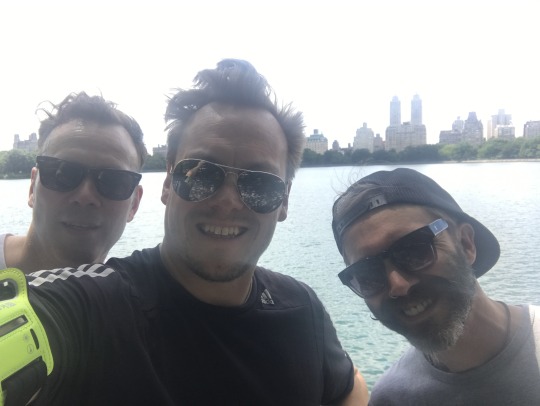
We then head off to another TV studio to perform on the Seth Myers Show. The studio is bloody freezing. It’s always the way with US TV shows. God knows why. There must be a reason. No idea what that is though. But it’s full jacket wearing performance for this show. Which is odd as it’s 27oC outside. A planned big night out in NYC is thwarted by jetlag that eventually kicks in too hard to ignore. Early night for us boring folk. How very un rock n roll…!!!
June 27
5am wake up. Not for any particular reason. Just jetlag. But that’s ok in NYC. I go out and wander the streets for 4 hours interspersed with coffee breaks. I still love this city. I lived here for 2 years back in 2006/7. It still feels like home. There’s an energy that emanates through the floor here. You can feel it coming out the walls of the buildings and skyscrapers. Everyone is here for a reason. There is a focus here that brings out the creative side in everyone who has one. I still love it and today I soak it up.
We are performing on Kelly and Ryan TV show today. Another freezing studio. A trailer filled with farmyard animals is parked right outside our dressing room. The odd ‘Moooo” and Baaahaaaa” interrupting James’ vocal warm up are highly amusing breaks to the tedious boredom of TV world. Still no idea why they were there as they never appeared on the show…!! Slightly gutted that the very cute Kelly is on holiday. It’s always a treat for the eyes playing on her show.
The boredom is abruptly shattered when we are told we have to lose 30 seconds of the track. We have already soundchecked so it’s a strategic edit arranged, board meeting style, around the table with no way of checking. Times like this we are thankful we are a fully live band with no backing track. We visually cue the changes live on air while being broadcast to millions. It’s times like this you know you are alive. It works. No time to stress or panic. We nail it. 3 mins dead. Everyone is happy. And we are done for the day. With nothing but a fight tomorrow, there is a palpable air of excitement amongst the band.
We head downtown to my favourite Italian restaurant in NYC called Emilio’s Ballato. It’s an old school mafia style Italian that I was introduced to when I lived here. Emilio is a terrifying, yet lovable character who sits at the door. Always does. Has done for decades. You only have to imagine a mafia style Italian restaurant owner with a gravelly voice who has to occasionally pop out to “take care of business” to know what he looks like. The mental picture you have now……. That’s Emilio. The first time I came here, Sting was sat at the first table with Jay Z and Rhianna. It’s that kinda place. Emilio Jnr takes us to a table and explains the menu in his “baddabing” way. It’s so cliché one or 2 of our party suspect it’s all a show. But I know for a fact it is not. The family back in Sicily send over the ingredients twice a week. All 3 of Emilio’s sons work at the place. It’s the real deal. And it’s awesome.

Tonight we are all on the guest list of the Imelda May gig at Webster Hall. Pembers, our keyboard player, is Imelda’s player too. He depped out the last 2 Imelda gigs as they clashed with the Blunt tour. But coincidence means we are all here in NYC. The band are amazing and Imelda’s voice soars in this place. A great old school sweaty gig. We hang out with the band at an Irish bar around the corner after the show. God knows what time we finished but it was a long hazy walk back to the hotel.

Goodbye NYC
June 28
Flight to Kansas today. We arrive to find they have not sent the mini bus that we asked for, but a car….!!! For 12 of us. So we squeeze in 3 cars with gear and bags on our laps. It’s not all glamour…!!

June 29 It’s the first day of our Ed Sheeran support today. Kansas City the first show. Still jetlagged. I’m up and wide awake at 5am. I decide to check out Kansas. I set off on a head clearing 90 minute walk. In the space of a few minutes, the sky turns apocalyptic black and I’m suddenly in the middle of an almighty downpour and a violent thunder storm. Flash floods come hurtling down the street. It’s actually pretty scary. But awesome too. Mother nature flexing her muscle and reminding us how insignificant we all are. Trash cans hurtling down the street. I run back to the hotel and watch the storm from the safety of my hotel window.
A post shared by JohnnyVic (@satellites_johnnyvic) on Jun 29, 2017 at 5:38am PDT
The tour bus pulls up outside our hotel. Always a hugely exciting moment. There’s something about American tour buses. It’s probably subconsciously linked to the childhood dream of touring the States that most musicians had at some point. But also just how cool the busses look. This is home for the next 2 months.

We get to the venue. The Sprint Arena. Sold Out 16,000. We meet Ed and all the crew. They are all super nice and friendly which is a welcome relief. It’s not always the case. The support act can occasionally be treated as a lesser entity. But not here. I think the fact James is such a big name in his own right helps. And the fact James and Ed are friends. Ed co-wrote some of the tracks on James’ new album and we even recorded one of them at Ed’s house earlier in the year.
We soundcheck the whole set. It feels a bit weird. Ed does his thing with just an acoustic guitar and a loop pedal. And rarely sound checks. So seeing all our full band gear on his stage feels a little intrusive on his minimal set. But again, Ed’s crew are all super helpful and asking if we need anything. We iron out a few issues from the rehearsals and drop a song as we creep over our allocated 40 mins.

My Bass Set up.
James and I then play a quick 3 song set unamplified on acoustic guitars for 25 competition winners. We haven’t worked out the songs before on acoustics so it’s very much on the fly. But they all seem thrilled.
Ed pops in to wish us luck as we all do our vocal warm ups. We go on.
It’s a younger crowd than we are used to. It’s quite clear pretty early on that a few of them have no idea who James is. I guess it is 12 years since his debut album was no.1 here in the States. But rather sweetly, you can see a lot of the crowd are holding their phones with the lyrics on and are attempting to sing along. So cute.

James announces “most of you were probably conceived to this song” as he strikes up the opening chords to the world wide smash that is “You’re Beautiful”. You can see the penny drop in the audience. And in a scene reminiscent of an 80’s style cheesy high school movie, the crowd slowly all get to their feet and whoop, with fists in the air as they all realise ‘it’s that guy’. It’s an amazing moment. And from that point on it’s an amazing show. James gets all the 16,000 to their feet as he piano surfs during the outro of our set.
We all come off and have a post gig huddle. It’s a success. There’s always a slight element of doubt before a support gig. But those doubts are put to bed tonight. Ed pops in before his set and pours us all a mandatory Tequila.
Ed hits the stage to an ear splitting shrill of 16,000 very excited people. It’s an amazing spectacle. Just a man and a guitar with a loop pedal. He is a master of his craft. Everyone is on their feet. From the hardcore fans at the front to the reluctant parents on the very back row, Ed has them all in the palm of his hand. With just the occasional look down at his loop pedal multi track set up, the accompaniments he makes on the fly with his voice and beating the guitar body for percussion, it’s seamless. And mighty impressive.

69 notes
·
View notes
Text
The Real Toys of “Toy Story 4”

Chatty Cathy Talking Doll, ca. 1963, an inspiration for Gabby Gabby. THF 173150
Since 1995, Disney-Pixar’s “Toy Story” films have led the industry in combining computer-generated animation with powerful, heartfelt stories. One of the reasons that adults and kids alike are drawn to these films is the clever selection of toys. More often than not, these are based upon real toys that are fondly remembered by viewers from different generations (see several examples of these from The Henry Ford’s collections in the blog post, “The Real Toys of Toy Story”).
This summer’s release of “Toy Story 4”—with its cast of old friends along with several newly introduced toys—allows us the perfect opportunity to once again delve into The Henry Ford’s collections and see what real toys provided inspiration for this fourth “Toy Story” installment.
The Heroes

Kentucky Fried Chicken Spork, 1978-90. THF173933
A heroic spork? Yes, indeed! This time around, Pixar decided to explore what would happen when a handmade toy named Forky (with a plastic spork for a body) meets the old gang of mass-manufactured toys.
Sporks have a long, mostly unsuccessful history. Think about it. When you combine a spoon and a fork together, neither of them is going to work very well. Interlocking or folding sets of camp utensils have always been more popular with backpackers and Boy Scouts. Nevertheless, by the 1970s, plastic sporks were making their way into fast-food restaurants—to use for, as Forky describes it, "soup, salad, maybe chili, and then the trash!” Kentucky Fried Chicken was one of the first fast-food chains to regularly feature sporks, like the one shown here.

Image of Little Bo-Peep as part of Mother Goose Series, trade card for baking soda, John Dwight & Co., 1900. THF294575
In “Toy Story 4,” Bo Peep returns as a much more assertive and heroic character. Here we learn that she was once part of a lamp that Andy’s sister, Molly, had in her bedroom to help her fall asleep. In fact, the classic nursery rhyme, Little Bo-Peep—first printed in full in 1810—reveals that this young shepherdess lost her sheep because she had also fallen asleep!
Other connections exist between the old nursery rhyme and the newer, more independent Bo Peep. n the nursery rhyme, Bo Peep’s sheep lose their way because sheep are known to flock together. In “Toy Story 4,” Bo Peep’s three sheep are also inseparable—in fact, they are molded together as one piece, leading to often humorous results! In addition, a shepherdess would have traditionally used her crook not only to manage her sheep but also to defend them from attack by predators. In the film, Bo Peep similarly uses her crook to keep our heroes from harm.

Polly Pocket Watch Happy Meal Toy, 1995. THF141193
The appearance of Giggles McDimple in “Toy Story 4” likely delighted girls who grew up in the 1990s, as Giggles and her “home” reference the highly popular Polly Pockets of that era. These were first conceived by a British Dad for his daughter in 1983, using a powder compact as a tiny house that could fit in a pocket. Bluebird Toys, of Swindon, England, licensed the concept when these first appeared on the market in 1989, with Mattel in charge of distribution. In 1998, Mattel purchased the rights to manufacture Polly Pockets, then immediately redesigned them into larger dolls with changing garments. While various versions were produced after that, the original minuscule figures with jointed legs and peg-like bases that slotted into holes inside their cases never returned.
In “Toy Story 4,” Giggles compensates for her minuscule size by displaying an air of confidence and a can-do attitude—just the kind of out sized personality that little girls of the 1990s might have ascribed to their own Polly Pockets.

Evel Knievel X-2 Sky Cycle Toy, 1976-8. THF 302676
Duke Caboom—"Canada’s Greatest Stuntman”—is not an exact imitation of Evel Knievel, but this “Toy Story 4” character was certainly inspired by the famed 1970s stunt daredevil. Robert Craig Knievel, who was known at an early age for his combined athletic prowess and guts, became a national sensation in the 1970s, when he was featured several times on “ABC’s Wide World of Sports.” nievel’s tremendous crowd appeal motivated Ideal to reproduce an action-figure version of him along with various stunt-related accessories—like this X-2 Sky Cycle that replicates the one he used during an attempted jump over Snake River Canyon, Idaho, in 1974.
During the peak of his popularity, Knievel’s flashy white leather jumpsuit and reputation for keeping his word helped reinforce his heroic, larger-than-life image. That is, until 1978, when he was convicted of assaulting the author of a book written about him and his popularity quickly plummeted. The tragic backstory of Duke Caboom and his kid who rejected him is a fitting connection to the real-life 1970s Evel Knievel and his young fans.
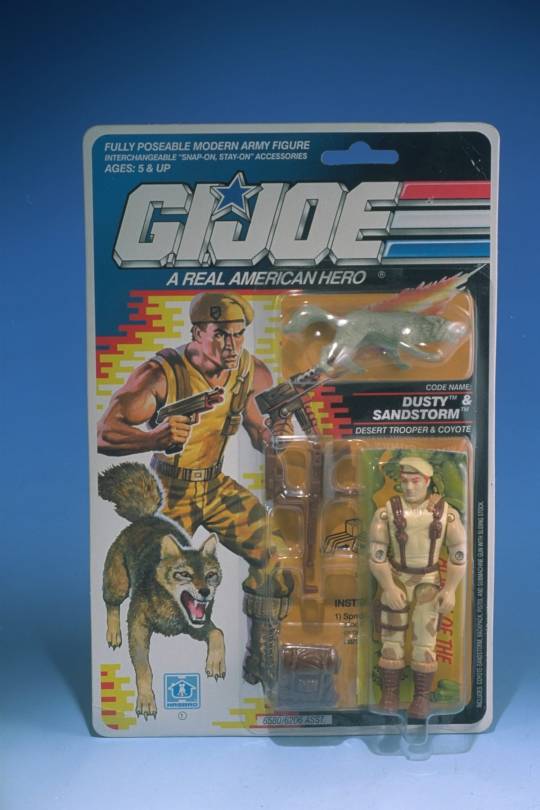
G.I. Joe Desert Troop Dusty with Sandstorm, his coyote, 1990-91. THF 94338
Combat Carl makes a small but unforgettable appearance in “Toy Story 4”—especially if you who stay to the very end of the credits. He played a bit part in the first “Toy Story” film, then a larger role in Pixar’s 2013 Halloween TV special, “Toy Story of Terror!” Combat Carl is an everyman military action figure reminiscent of G.I. Joe action figures of the 1980s and ‘90s. Mattel introduced the first G.I. Joe in 1964—a 12” poseable version that directly referenced the military men who saw action during World War II and the Korean War. An African-American version of G.I. Joe was introduced in 1965.
As a result of the unpopular Vietnam War in the late 1960s and the rising price of plastic in the 1970s, G.I. Joes declined in popularity until they were discontinued in 1978. But they made a stunning comeback during the 1980s as 3-3/4” adventure-team action figures. This G.I. Joe action figure from The Henry Ford’s collection, named Dusty, was introduced in 1991, after the Persian Gulf War inspired toys based upon the real-life conflict. Exuding a great deal of self-possessed machismo but also tugging at our heartstrings a bit, Combat Carl always leaves us rooting for him.
The Villains
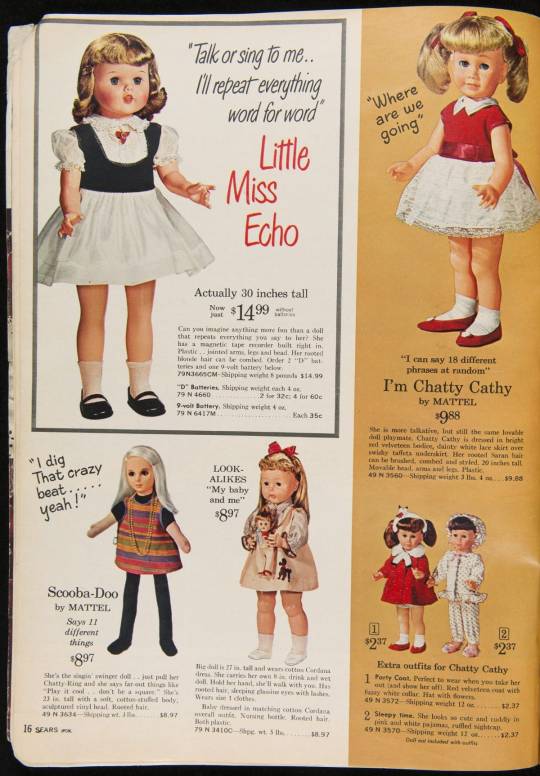
Shown on the right side of the page, Chatty Cathy is featured in the 1964 Sears Roebuck & Co. Christmas Catalog. Note her Gabby Gabby-like freckles! THF287020
At first glance, the scheming Gabby Gabby appears to have been based upon Chatty Cathy, introduced to the American public in 1960 as the first in a new line of Mattel talking dolls. Like Gabby Gabby in the film, Chatty Cathy’s “voice” was activated by a pull string in the back. The first Chatty Cathy, who had blue eyes and sported a blonde bobbed hairdo, recited 11 phrases at random via a record that was driven by a metal coil wound by pulling the toy’s string. Her phrases were voiced by June Foray, also famous as the voice of Rocky the Squirrel in “The Rocky & Bullwinkle Show.” Newer versions of the doll sported a wider choice of hair and eye colors as well as an African-American version. By 1963, when this version of Chatty Cathy was introduced, she had long pigtails and her vocabulary had increased to 18 phrases.
According to director Josh Cooley, Gabby Gabby was based more directly upon an evil doll named Talky Tina, who appeared in a 1963 “Twilight Zone” episode. In this edge-of-your-seats episode, a family’s problems are made worse when a talking doll—which was loosely based upon Chatty Cathy and was also voiced by June Foray—develops a mind of her own and wreaks havoc on the family, inevitably leading to a tragic ending.
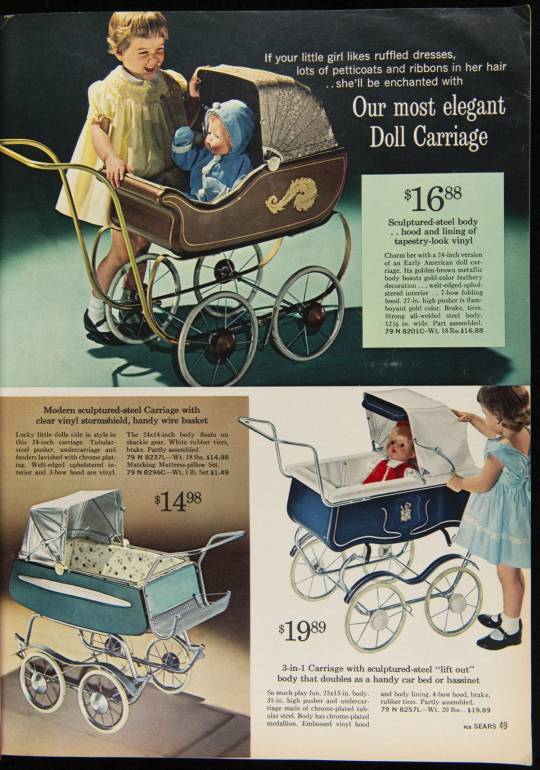
Page of doll carriages, Sears Roebuck & Co. Christmas Catalog, 1964. THF294577
As Woody and Forky search for Bo Peep in the quiet atmosphere of the antique shop, the sudden sound of a squeaky doll carriage edging closer but just out of view is one of the more hair-raising moments in the film. Sure enough, it reveals itself as Gabby Gabby’s mobility device and there is good reason for viewers to be nervous. Some of us have a visceral memory of those squeaky doll carriages of the mid-20th century, before safety and cost issues replaced the carriages’ metal and vinyl parts with plastic.
Doll carriages were generally based upon full-size baby carriages of their era. In the late 19th century, these were often quite elaborate, made of wicker with brass fittings and matching parasols and only affordable to the wealthy. As the 20th century progressed, pop-up tops, removable beds, and suspension systems made baby carriages more comfortable and convenient, and they also became more affordable to families of different economic levels. The three options shown in this 1964 Sears Roebuck Christmas catalog—of varying prices and materials—are all reminiscent of Gabby Gabby’s squeaky—and sneaky—doll carriage.
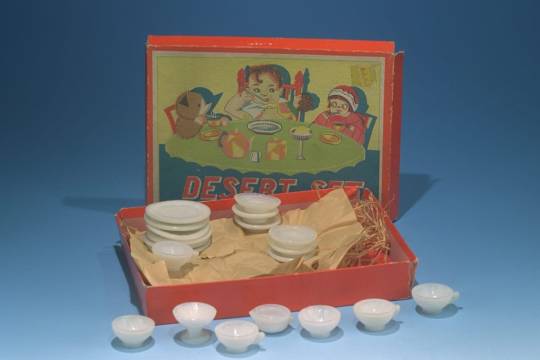
Doll Dessert Set, 1935-40. THF141192
In “Toy Story 4,” Gabby Gabby is delighted when the antique shop owner’s granddaughter, Harmony, sets up a toy tea set and pretends to take tea—hoping beyond hope that when her voice box is fixed, Harmony will invite her to join in.
Since the 19th century, miniature tea sets were a traditional way for little girls to practice adult skills and feminine roles. It was up to them, however, to decide whom to invite for company. Images, like the cover of this doll dessert set, often show little girls having tea with favored dolls and stuffed animals. Indeed, in previous “Toy Story” movies, we saw both neighbor Sid’s little sister and young Bonnie engage in this type of imaginative play. The strengthening of bonds between little girls and their dolls through pretend tea-drinking is something that Gabby Gabby desperately wants—so much so that she will resort to desperate measures to have it.

Charlie McCarthy Doll, 1937-40. THF106436
Without a doubt the creepiest characters in “Toy Story 4” are the Bensons—the group of ventriloquist dummies that Gabby Gabby enlists to do her bidding. Dating back to 18th-century traveling fairs, ventriloquists “threw” their voices to appear as if they were coming from elsewhere, usually a puppet or other semi-lifelike figure referred to as a dummy. During the early 20th century, Edgar Bergen popularized the idea of comedic ventriloquism, teaming up with his “cheeky,” boyish dummy, Charlie McCarthy. Edgar Bergen and Charlie McCarthy became so popular that they appeared on “The Chase & Sanborn Radio Hour” from 1937 to 1956, as well as later films and TV programs. As shown here, Charlie McCarthy was reproduced by Effanbee as a child’s toy, complete with different outfits and a carrying trunk.
The Charlie McCarthy dummy and related doll were not intended to be evil (although some people would maintain that all ventriloquists’ dummies are creepy). redit for that goes to the fact that the Bensons were more directly inspired by a series of “Goosebumps” books by R. L. Stine that began in 1993, featuring the villainous Slappy the Dummy. Though the book is from a later era, Slappy’s appearance recalls the ventriloquist dummies of Charlie McCarthy’s time. In “Toy Story 4,” the Bensons have no voices because there are no humans to provide them. And their bodies are soft with no structure because, without humans to operate them, their body parts just dangle. Very clever! And definitely creepy!
Will there be a “Toy Story 5”—with new toys, the return of familiar old toys, and a fresh spin on their interconnecting stories? Only time will tell.
Donna R. Braden is Senior Curator and Curator of Public Life at The Henry Ford.
#1 Ford Daily | Đại lý – Showroom ủy quyền Ford Việt Nam 2019 Ford Daily là showroom, đại lý Ford lớn nhất Việt Nam: Chuyên phân phối xe ô tô FORD như: EcoSport ✅ Everest ✅ Explorer ✅ Focus ✅ Ranger… [email protected] 6A Đường Trần Hưng Đạo, Phường Phạm Ngũ Lão, Quận 1, Hồ Chí Minh 711240 0901333373 https://forddaily.com/ https://forddaily.com/xe/ https://forddaily.com/dai-ly/ https://forddaily.com/bang-gia/ https://forddaily.com/tra-gop/ #forddaily #dailyfordhcm #fordshowroomhcm https://www.google.com/maps/place/Ford+Daily/@10.7693359,106.696211,15z/data=!4m5!3m4!1s0x0:0x1f188a05d927f4ff!8m2!3d10.7693359!4d106.696211
0 notes
Text
The Vindication of Venom Part 3: Expectations

Part 2
Part 4
Now its time to get down to the real business of this essay and tackle the most vocal and frequent criticisms of Venom. Namely his original host Eddie Brock and his motives for hating Spider-Man. The first step to doing this though is to establish the expectations fans had for the character vs the actual intended concept behind him.
In part one I listed what I feel are the major criticisms of Venom and how I intended to address them one by one. In really thinking about it though I’ve realized that course of action would prove too difficult to properly dive into my points about Brock. Many of the criticisms surrounding him and many of my counterpoints to those criticisms are too interlinked with one another to be separated out like that.
As such I’m just going to talk about Brock more generally.
But as a reminder here are the points about him which I listed in Part 1:
· Eddie Brock’s motivations for hating Spider-Man are weak and make no sense
· Brock’s origin story involves rewriting events from the Sin Eater storyline to facilitate his fall from grace
· Brock was a previously unknown character who is unconnected to Peter Parker’s life in or out of his costume.
· The reveal of Brock as Venom, especially in light of previous two points, is a bad resolution to the mystery story seeded in issues leading to ASM #300
· Other versions of the character (such as Spider-Man the Animated Series, Spider-Man 3 and the Spectacular Spider-Man Animated Series) all make Brock to be a much better dark reflection of Spider-Man than the original comic book version
In my introduction I stated that my thesis for defending Venom was that he was more poorly communicated and readers projected unwarranted expectations onto the character. Brock is really where those two aspects come to the forefront.
Venom visually looks like Spider-Man, or rather how Spider-Man had looked for a few year before ASM #300 given that he’d off and on been wearing the black costume. In ASM #300 Venom also displayed enhanced strength and speed as well as the ability to wall-crawl and generate webbing. Half of Venom came from the alien symbiote which had in the past granted other hosts abilities similar to Spider-Man.



And of course Venom’s primary colour was black, a colour commonly associated with evil in Western cultures.
It is my belief that all these things combined caused readers upon learning someone else had the symbiote and consequently in seeing Venom himself, to expect the character to be a kind of evil Spider-Man, a dark reflection of the character.
This expectation coupled with his shadowy build up and debut in ASM #299-300 heightened fan anticipation for the character to be a big, big, big deal. Far bigger I think than if he had debuted in any given issue of Spider-Man that wasn’t a milestone of some kind, especially if it happened in Web of Spider-Man (the youngest Spider title) as originally intended.
After all, an evil version of the hero is a time honoured tradition (especially in superhero comics) and one that for Spider-Man had never directly been instigated in his then 25+ years of publication. The lack of such an archetype in the series for such a long time might possibly have further enhanced fan anticipation to finally see such a character in the pages of Marvel’s flagship character. And for that type of character to debut in such a momentous issue as ASM #300 meant readers were hyped to say the least.
Given these expectations it is no wonder that the character on the page proved disappointing to them.
Furthermore, readers from later generations would have their own set of expectations for the Venom character.
For many fans of Spider-Man of my generation (I was born in the early 1990s), we learned of Venom from the numerous merchandise he was featured on and more importantly from the 1994 Spider-Man animated series. Among the things the cartoon innovated when it came to Venom was the ideas that the costume brought out the darkside of its host, that Eddie Brock was an established member of Spider-Man’s supporting cast before he became Venom and that he blamed Spider-Man for ruining his life due to a series of misunderstandings.
So impactful and definitive was this version of Venom that elements from it were featured in consequent adaptations (including Spider-Man 3 and the Spectacular Spider-Man TV show) and various comic renditions of the character (e.g. Ultimate Spider-Man).
In fact the 1994 cartoon version made such a potent impression that there are long time Spider-Man fans who were around during the original debut of the black costume who believe that those original comics contained elements from the 90s cartoon’s take on the symbiote, chiefly the notion of the costume as a corrupting influence on Spider-Man.
For those fans and the ones of consequent generations Venom is on the Mount Rushmore of Spider-Man characters and villains, definitively standing alongside Green Goblin and Doc Ock as the A-listers of Spider-Man’s rogue’s gallery.
Now something very important to note going forward is the fact that adaptations such as Ultimate Spider-Man, Spider-Man 3 and the Spectacular Spider-Man Animated Series all played Venom/Brock as something of a dark reflection of Spider-Man/Peter Parker.
In USM and the Spec cartoon Peter and Eddie were childhood friends who’s fathers worked together and died in the same plane accident, both later following in their fathers’ footsteps becoming science students themselves.
In USM whilst Peter was presented as a pretty nice kid still very much in love with his recent ex-girlfriend Mary Jane Watson, Brock was presented as a college aged creep who tried to take advantage of the underage high schooler Gwen Stacy (who’d recently lost her father) and derided her as a ‘tease’.
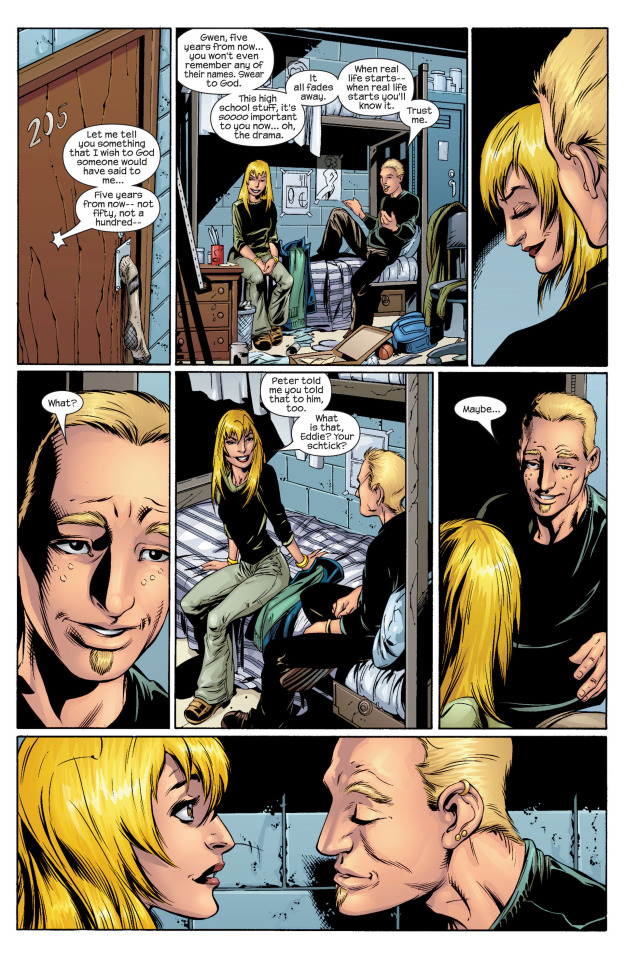
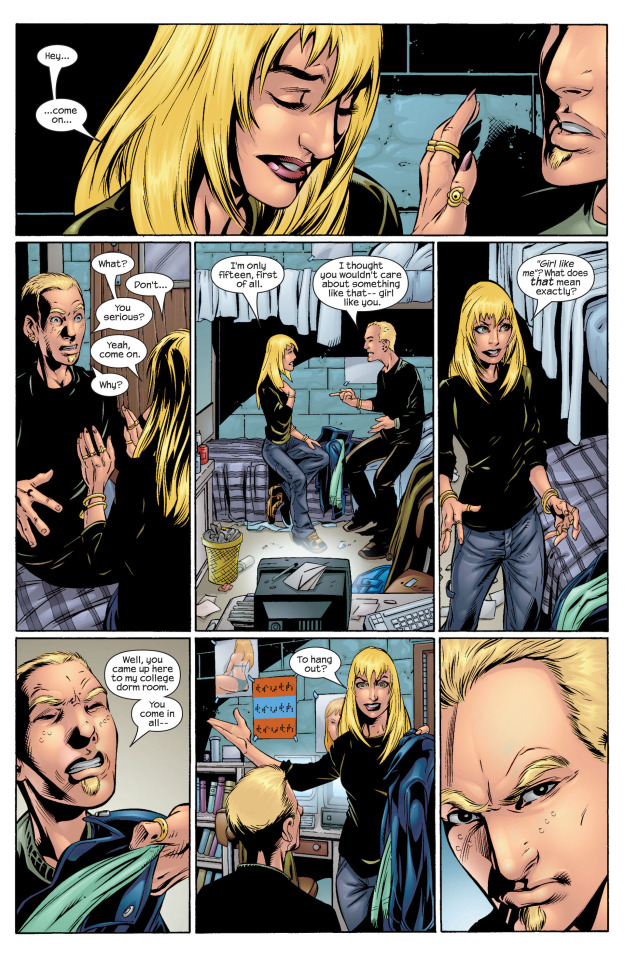
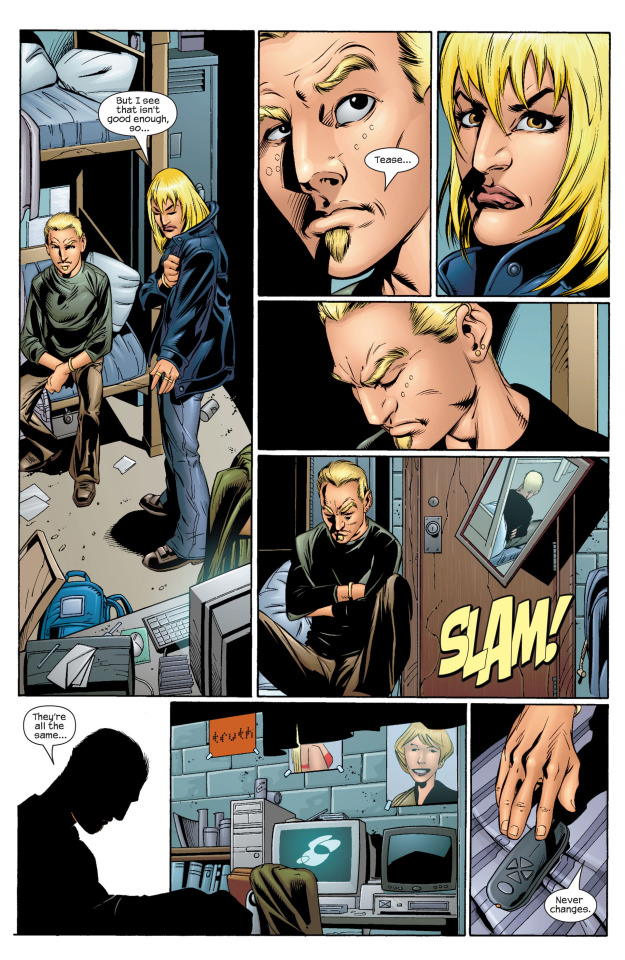


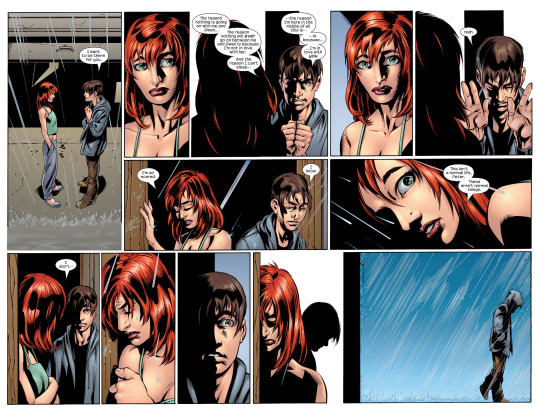
In this version of the story, the alien costume is actually a lab created ‘suit’ Peter and Eddie’s fathers were working on, based upon Richard Parker’s DNA. When Peter wears the suit it mostly works fine but affects his emotions and transforms him into a monster resembling Venom. When Brock wears the suit, partially due to it not being based upon his DNA and partially due to his own mind and emotions, he becomes an even worse monster with even less control than Peter had.

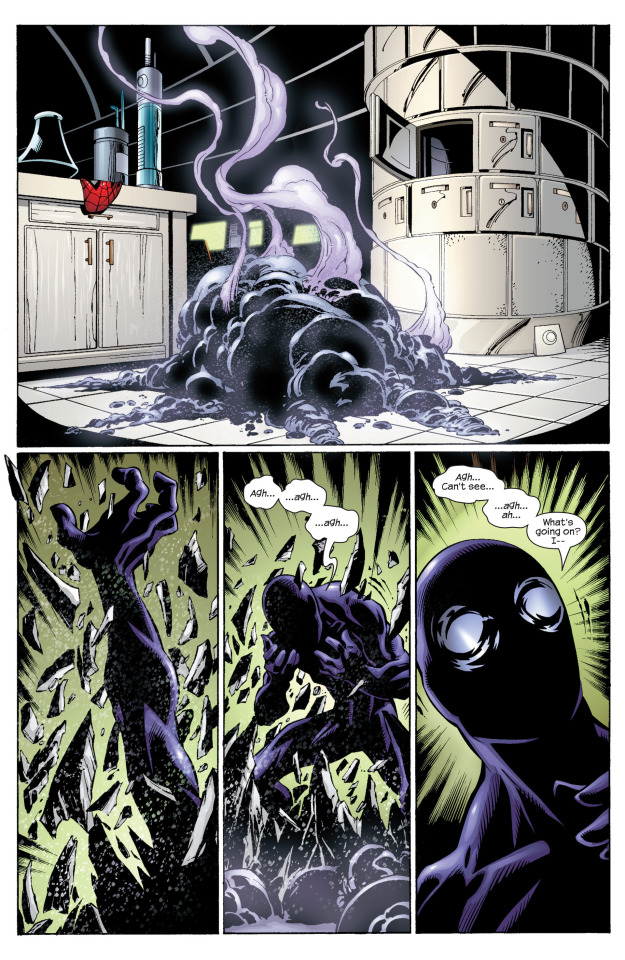


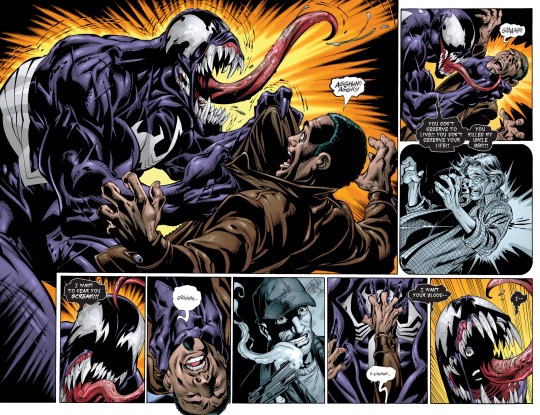




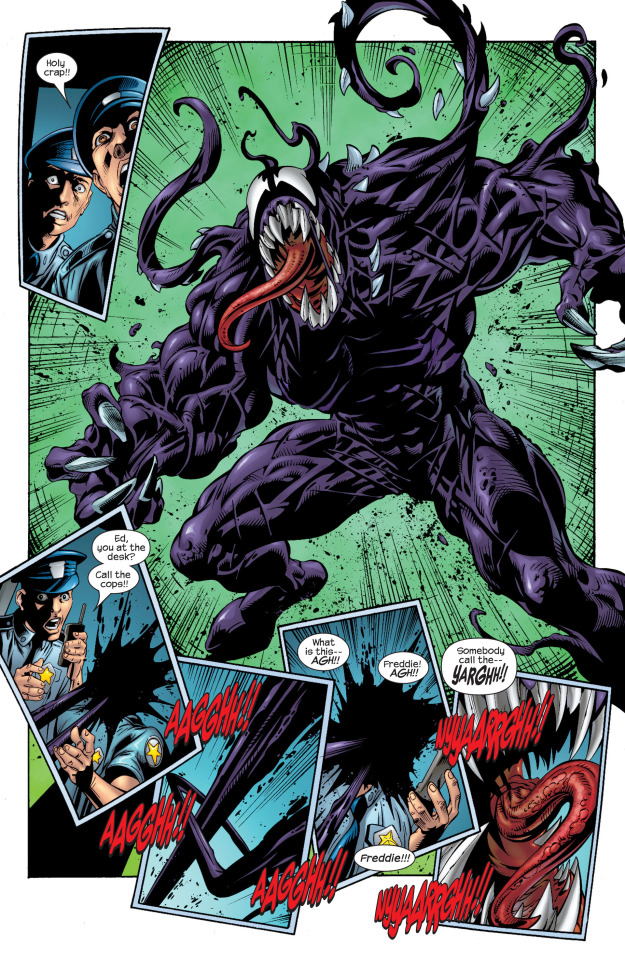
Meanwhile in the Spec cartoon a stark difference is drawn between Peter and Eddie by virtue of, following the deaths of their parents, Eddie being raised alone whilst Peter had Uncle Ben and Aunt May and by extension Eddie becoming somewhat ‘in love’ with death whilst Peter came to appreciate life.
In Spider-Man 3 Eddie Brock was a Bugle photographer like Peter Parker (who was around a similar age), interested in Spider-Man pictures and also loved a beautiful woman from afar (Gwen Stacy), which was not dissimilar to Peter’s feelings for Mary Jane in the previous two films.
What must be remembered going forward was that the 1994 cartoon despite having Brock work at the Bugle (as a writer, not a photographer, although in one episode he did take a few photos) did not play Brock in any of the ways described above as far as being a dark reflection of Peter/Spider-Man is concerned. He wasn’t particularly concerned with chasing stories about Spider-Man, his attitude towards women was not compared or contrasted to Peter’s, he and Peter did not have any personal history, his parentage was never mentioned and he was most definitely not involved with science.
With these portrayals in mind and his impact/legacy within the franchise as a whole many fans going back to check out the character’s true beginnings have been unpleasantly surprised to find Venom and his origin a far cry from what they knew or expected.
I think this plays a very major role in the derision Venom’s origin story has within the fandom as essentially many fans hold Venom in contempt for not being like their wider pop cultural understanding of the character. Or at least not like the version(s) they like and/or are familiar with from adaptations.
In the comics the symbiote never acted as a corrupting force upon Spider-Man, Eddie Brock was not established ahead of his debut as Venom, was not someone Peter had a friendship with, there was no established animosity between the two characters, the symbiote did not act as a corrupting force on Brock turning an already bad person monstrous and Brock was never someone who operated as a dark reflection in the ways outlined above. The absence of all these things results in disappointment from readers who come to ASM #300 expecting to see them in some capacity.
Whilst I feel a lot of these ‘unfulfilled expectations’ are not intentional on the part of fans it is nevertheless very unfair as a point of criticism. After all why should a character or story be regarded as bad because adaptations based upon it went in different directions? If anything, wouldn’t it be at least equally valid to lambast those adaptations of Venom from deviating so significantly from the source material?
Regardless, my point is that Venom in ASM #300 fails to meet the expectations of fans from before and after the issue’s release for different reasons and that disappointment from both camps contributed to the dominant narrative of his origin being simply inherently bad.
My proposal however is that those expectations projected onto Venom’s debut were misplaced and as such not fair criteria to evaluate the character against.
That is to say I not believe Venom was ever conceived to be:
a genuine traditional mystery character
a dark reflection of Spider-Man (not in the way adaptations play him anyway)
someone who’d make a massive impact upon Spider-Man’s life
someone who’d hold an inherent connection to him.
Think of it like this.
When an audience member believes the piece of media they are consuming is (or is trying to be) one particular concept or genre they then (knowingly or otherwise) evaluate it based upon what they feel are the common tropes and ‘rules’ of that concept/genre.
For example someone watching a romance movie will be judging it based upon how believable the romance at the centre of the story is, the chemistry between the actors, etc. But if someone walks into an action movie expecting it to be a romance film and continues to believe it is trying to be a romance movie, the movie is going to seem bad to them. All because they missed the fact that it was never a romance movie to begin with.
This is what I believe is what happened with Venom.
Through some unclear writing and quirks of fate a lot of people just missed what the intrinsic ideas behind the character were and in doing so used the wrong set of criteria to judge him by.
Which raises the question of what exactly were the concepts underpinning the character then? For that you’ll have to read Part 4.
Part 2
Part 4
#Venom#Spider-Man#Eddie Brock#Peter Parker#David Michelinie#spectacular spider-man animated series#marvel#marvel animation#marvel comics#symbiote#symbiotes#venom symbiote#Ultimate Spider-Man#Spider-Man 3#sony#sam raimi#greg weisman#Brian Michael Bendis#The Vindication of Venom
36 notes
·
View notes
Text
A-HA – The Last Hurrah
by
Barry Page
|
posted in:
Features
|It’s hard to conceive it all comes to an end
In October 2009, A-Ha announced they were to split following a final world tour. Here The Electricity Club looks back at the career of the Scandinavian phenomenon, and reports from the Brighton Centre, the scene of one of their final UK shows.
It has already been an incredible year for fans of the Norwegian trio, one that has seen the release of remastered editions of Hunting High and Low and Scoundrel Days, an updated version of Jan Omdah’s insightful book The Swing of Things, a final single ‘Butterfly, Butterfly’<, a perfectly sequenced compilation album 25 and, finally, a medium where Morten Harket, Paul Waaktaar-Savoy and Magne Furuholmen have become increasingly more comfortable with over the years: the live arena. The band officially retired following four nights at the Oslo Spektrum on 4th December 2010.
It’s the first night of the UK leg of A-Ha’s 70-date Farewell Tour, subtitled Ending on a High Note. And the popular Norwegian trio are doing just that, rounding off a memorable career with a tour and setlist that encompasses every facet of their illustrious 25-year journey. “Let’s make it a celebratory thing,” announces keyboardist Furuholmen a few songs into the set.
The build-up to the finale in Norway’s capital is ten dates in the UK; and the British market has certainly served the trio well since ‘Take On Me’ made its global stranglehold on the charts 25 years ago. Of course it was Jennifer Rush’s corny ballad ‘The Power of Love’ that prevented this iconic single from hitting the top of the charts in the UK in 1985, and the history books show ‘The Sun Always Shines On TV’ as their only number one hit in this territory. It’s this powerful synth-rock epic that they open with tonight. Somewhat surprisingly, it is one of only three songs from their debut album that they will play tonight, and it’s a disappointment not to hear the likes of ‘Train Of Thought’ and ‘Living A Boy’s Adventure Tale’. Those fortunate enough to see them at the Royal Albert Hall in October will have delighted in the fact that they played their first two albums in their entirety.
Scoundrel Days (arguably their best album), is well represented tonight though, and accounts for almost a quarter of the 21-track set. Its brilliant bloodstained title track is given another well-deserved airing, with its bleak, tension-filled verses and a soaring chorus that has become something of a trademark. The south coast crowd are also treated to a rather raw version of the epic ‘Manhattan Skyline’, which is punctuated with some beautiful harpsichord playing by Furuholmen and some unsettling bursts of megaphone singing from reluctant frontman Harket. ‘I’ve Been Losing You’s opening bars still send shivers down the spine after all these years, while ‘We’re Looking For The Whales’ gets a surprise inclusion in the set at the expense of ‘The Swing Of Things’. ‘Cry Wolf’ gets an extended workout with some pounding drums from drummer Karl-Oluf Wennerberg, and Furuholmen even manages to subtly incorporate hints of The Doors’ ‘Riders On The Storm’.
Of course, it was the legendary Californian quartet who were to prove influential on recordings such as the East Of The Sun West Of The Moon album; and on earlier tracks such as ‘Here I Stand And Face The Rain’, you can certainly hear their influence. A-Ha have also been influenced by other 60s luminaries over the years such as The Beatles and The Everly Brothers. Tonight the latter’s ‘Crying In The Rain’ is performed during a momentum-halting mid-show campfire spot alongside swansong ‘Butterfly, Butterfly’ and ‘(Seemingly) Nonstop July’ where the band are reduced to playing a baby grand piano and acoustic guitar.
A-Ha’s 60s influences were certainly more prevalent in the early 90s as the band gradually moved away from the electronics that had permeated their earlier recordings. By 1993’s Memorial Beach album, A-Ha had finally shrugged off their poster-boy image as they adopted a fuller, rockier sound for the American market. From that album they play ‘Move To Memphis’ during a first half of the set that is dominated by hit singles.
Following the Memorial Beach album, A-Ha were placed on hiatus while Harket commenced a solo career, and Waaktaar-Savoy formed the sadly overlooked indie-pop band Savoy with his wife Lauren. Meanwhile, Furuholmen dabbled in soundtrack work whilst continuing to pursue his interests in the art world. Fast forward to the new millennium and the end of A-HA’s so-called ‘seven-year-itch’, and the newly-focused trio were a slightly more democratic affair; less reliant on the tension-fuelled creativity of Messrs Waaktaar-Savoy and Furuholmen, and employing more of Harket’s lighter material. With chief songwriter Waaktaar-Savoy effectively writing for 2 bands, Furuholmen was able to build on his reputation as an excellent songwriter with beautiful compositions such as ‘Lifelines’ and ‘Birthright’. By 2005’s Analogue album, they were once again flirting with a rockier sound. At the Brighton Centre they perform the title track of that album, with its simplistic piano riff and huge chorus, and the laconic Waaktaar-Savoy is given another chance to rock-out. From 2002’s Lifelines opus we get the Harket-penned ‘Forever Not Yours’ and from Minor Earth Major Sky we get the powerful title track and ‘Summer Moved On’, the vocal ‘tour-de-force’ that announced their reunion in 1998. Incredibly, even at the age of 51, Harket can still hit those notes and you soon forget how ropey the sound in the auditorium is.
By 2009, A-Ha were revisiting their electronic roots. Foot Of The Mountain, which easily sits alongside some of their best work, was a solid 10-track album that proved it was possible to be both contemporary and retro. It played to the band’s strengths, with all the material being penned by Waaktaar-Savoy and Furuholmen. Synth Britannia influences such as Depeche Mode can be heard on tracks such as ‘What There Is’. Indeed, in recent years the band have covered ‘A Question Of Lust’, and also Soft Cell’s ‘Say Hello, Wave Goodbye’. Elsewhere on the album, the beautiful epic closer ‘Start The Simulator’ recalls vintage OMD, when the Liverpudlian duo were writing intelligent pop songs about oil refineries and the atomic bomb.
And let’s not also forget that ‘Take On Me’s main synth riff was composed in 1981.
Debut album Hunting High and Low also has another key Synth Britannia connection – the bulk of it was produced by Tony Mansfield who had previously fronted the synthpop act New Musik. Mansfield would later produce the likes of Naked Eyes, whose debut album Burning Bridges is notable for being one of the first albums to significantly feature the Fairlight CMI, an instrument that was to feature heavily on A-Ha’s debut. Mansfield also produced the original version of ‘Take On Me’ that was released in 1984 selling just 300 copies, before Alan Tarney was recruited to produce the timeless version that we all know and love. It’s funny to think that A-Ha’s two biggest hits were helmed by a man synonymous with writing and recording for Cliff Richard, but Tarney’s pop sensibilities were to prove crucial while the band were developing their sound, and his services were retained until 1990.
Unsurprisingly, it is *that* single which is played in a finale that includes a rather overblown version of ‘The Living Daylights’, the James Bond theme from 1987 that indicated just how far this Norwegian export had come in the space of just a few years. At this point in the show, the people in the balconies finally wake up and rise to their feet, but it all feels like an anti-climax as emotion quickly turns to cynicism. Is this supposed farewell tour a shameless marketing opportunity, or will this pop phenomenon reunite again in the future? It’s perhaps too early to speculate at this stage as Harket is expected to resume his solo career, and prolific songwriter Waaktaar-Savoy will be turning his attentions to Savoy in the New Year. They have already released six albums since 1996, including a career-rounding retrospective. Furuholmen, who revealed this year that he has been suffering from a heart condition, has announced his intent to work with members of Muse and Coldplay. As for A-Ha their place in the pantheon of intelligent pop music is already assured, and they leave a legacy of nine albums and some wonderful, melancholic pop songs.
www.a-ha.com
Photos by Lori Tarchala 4th December 2010
0 notes